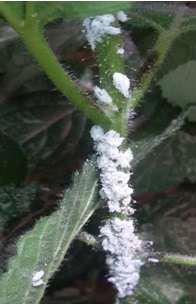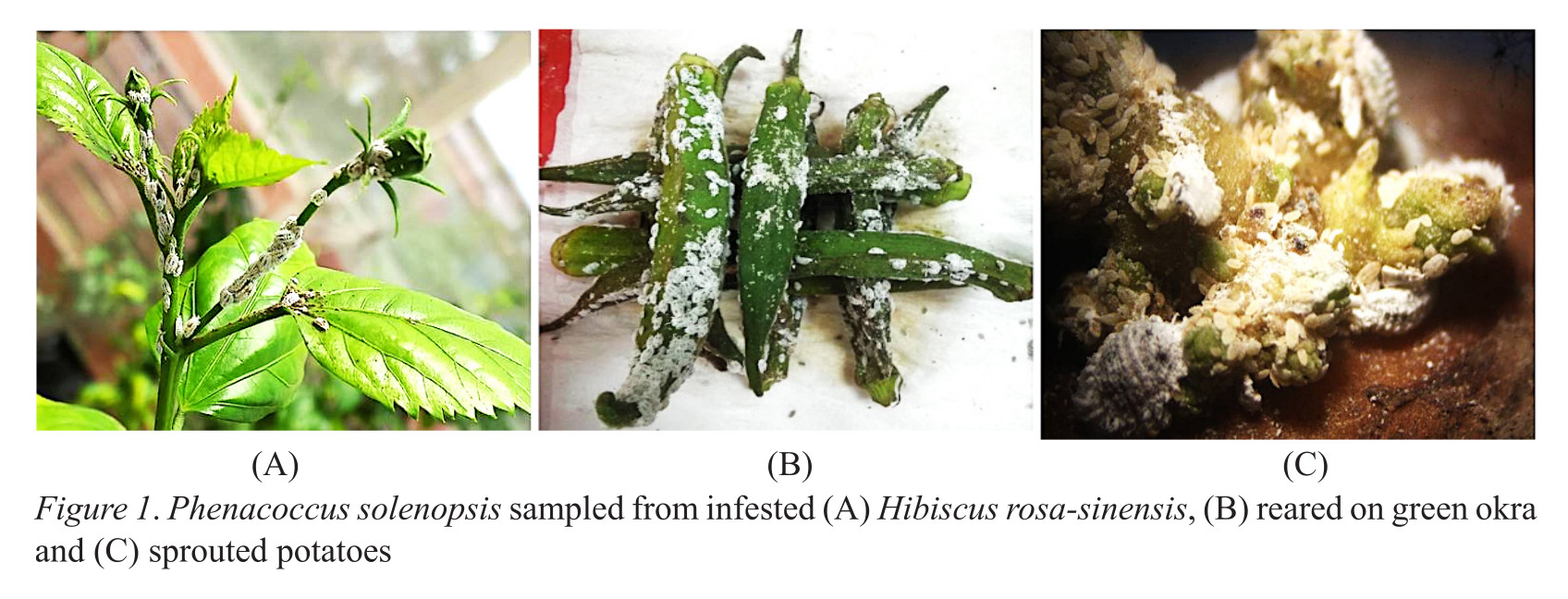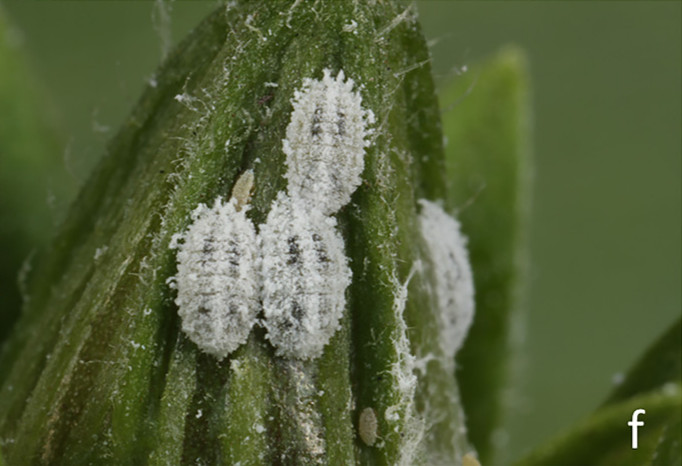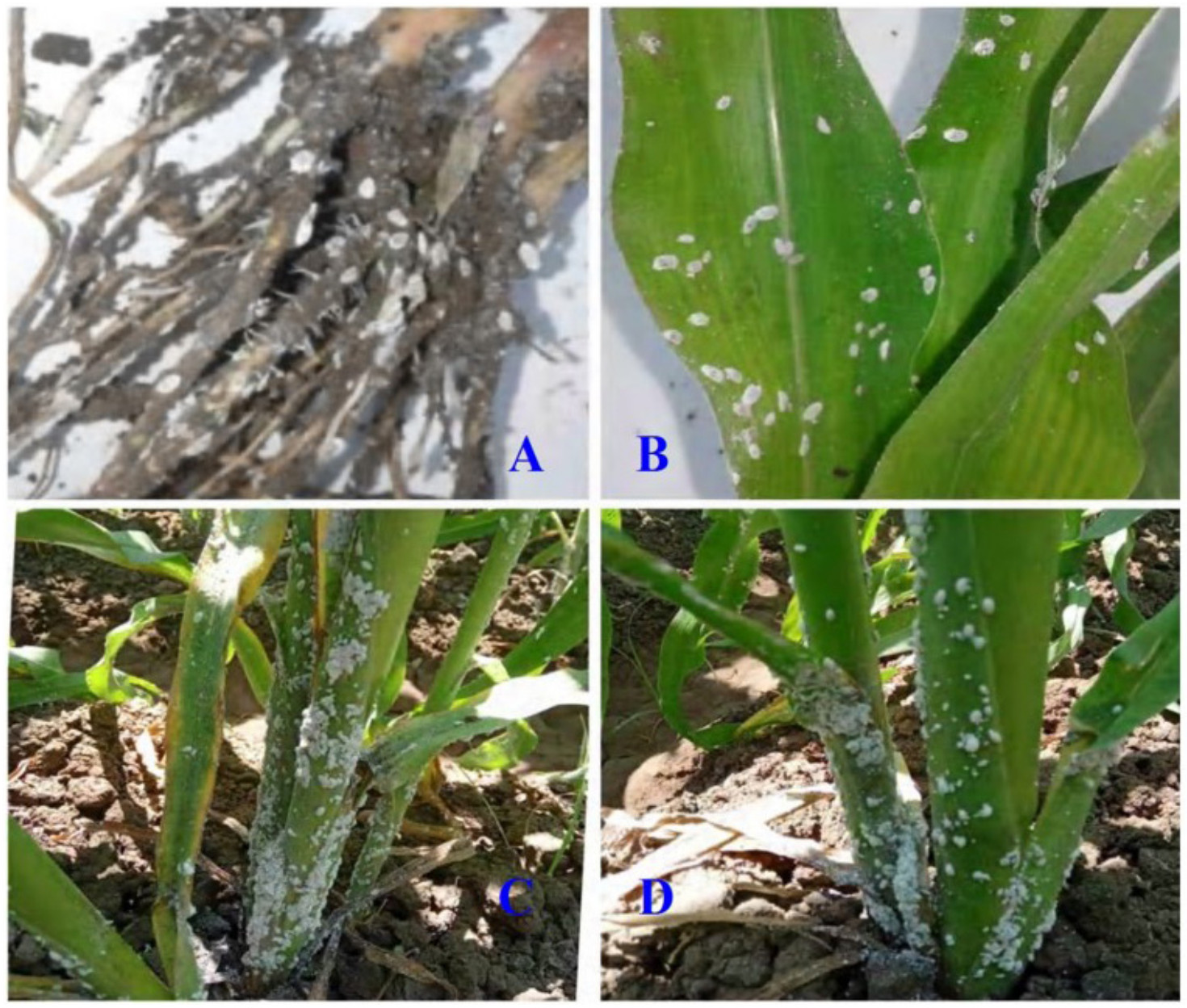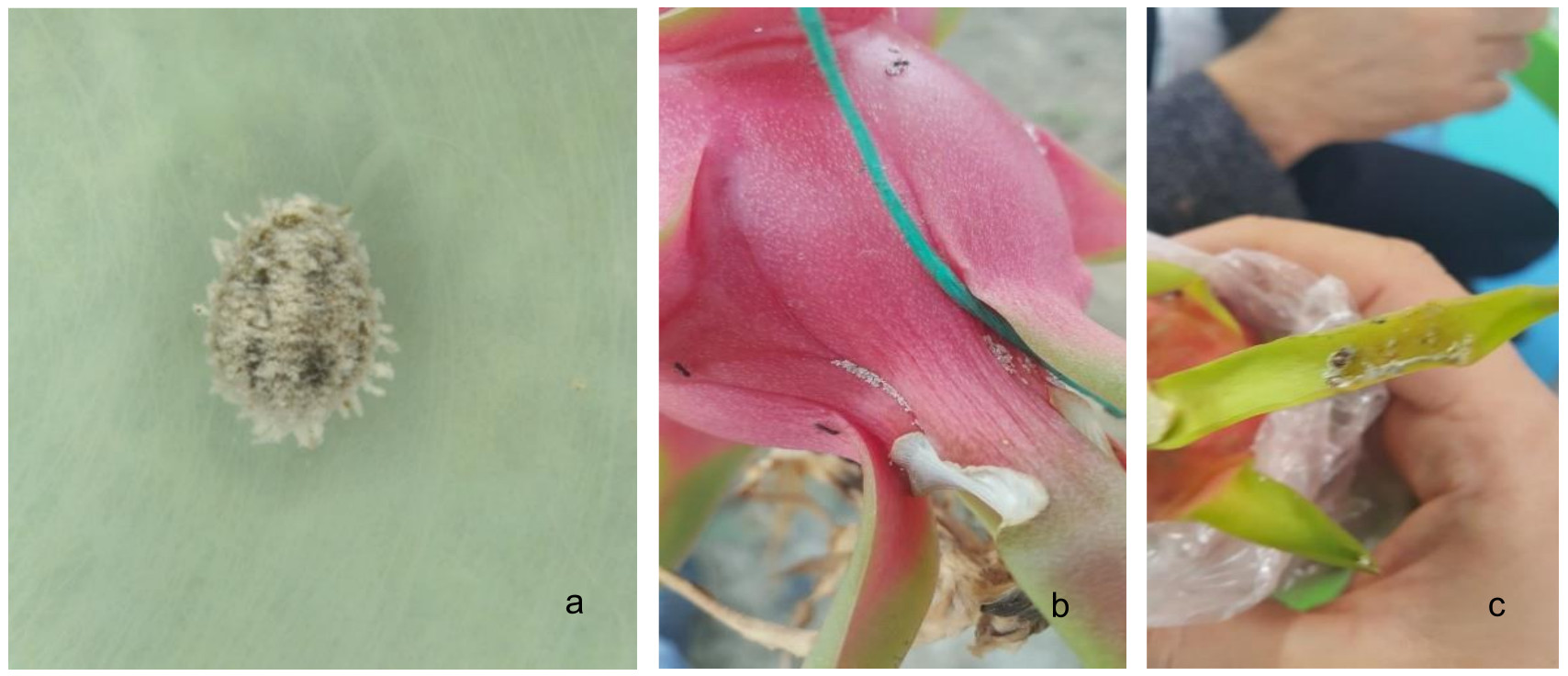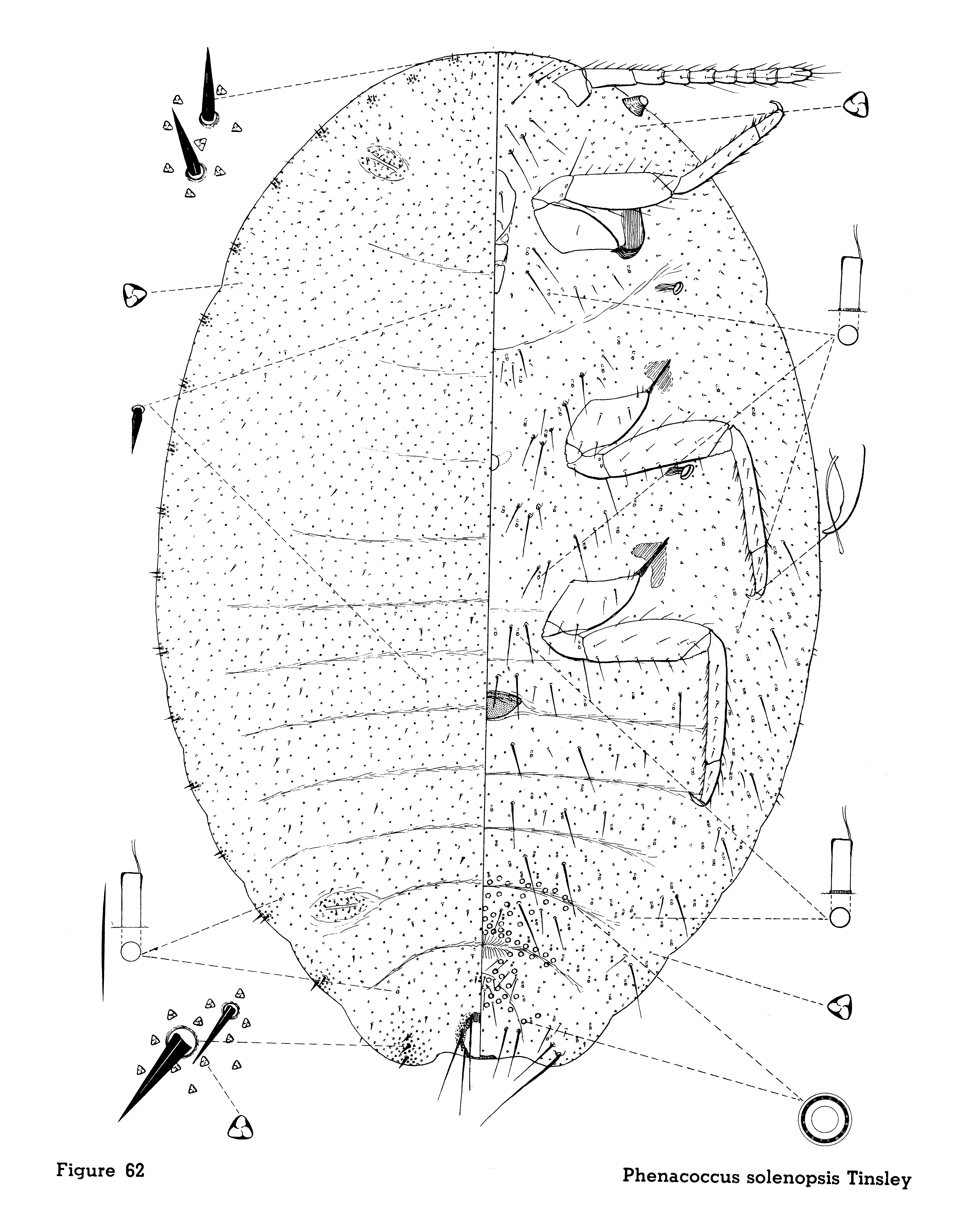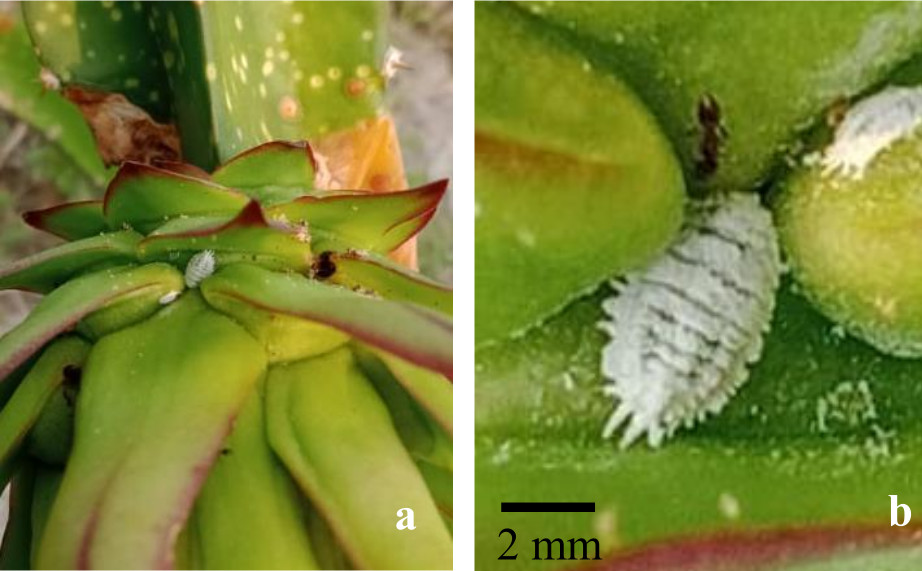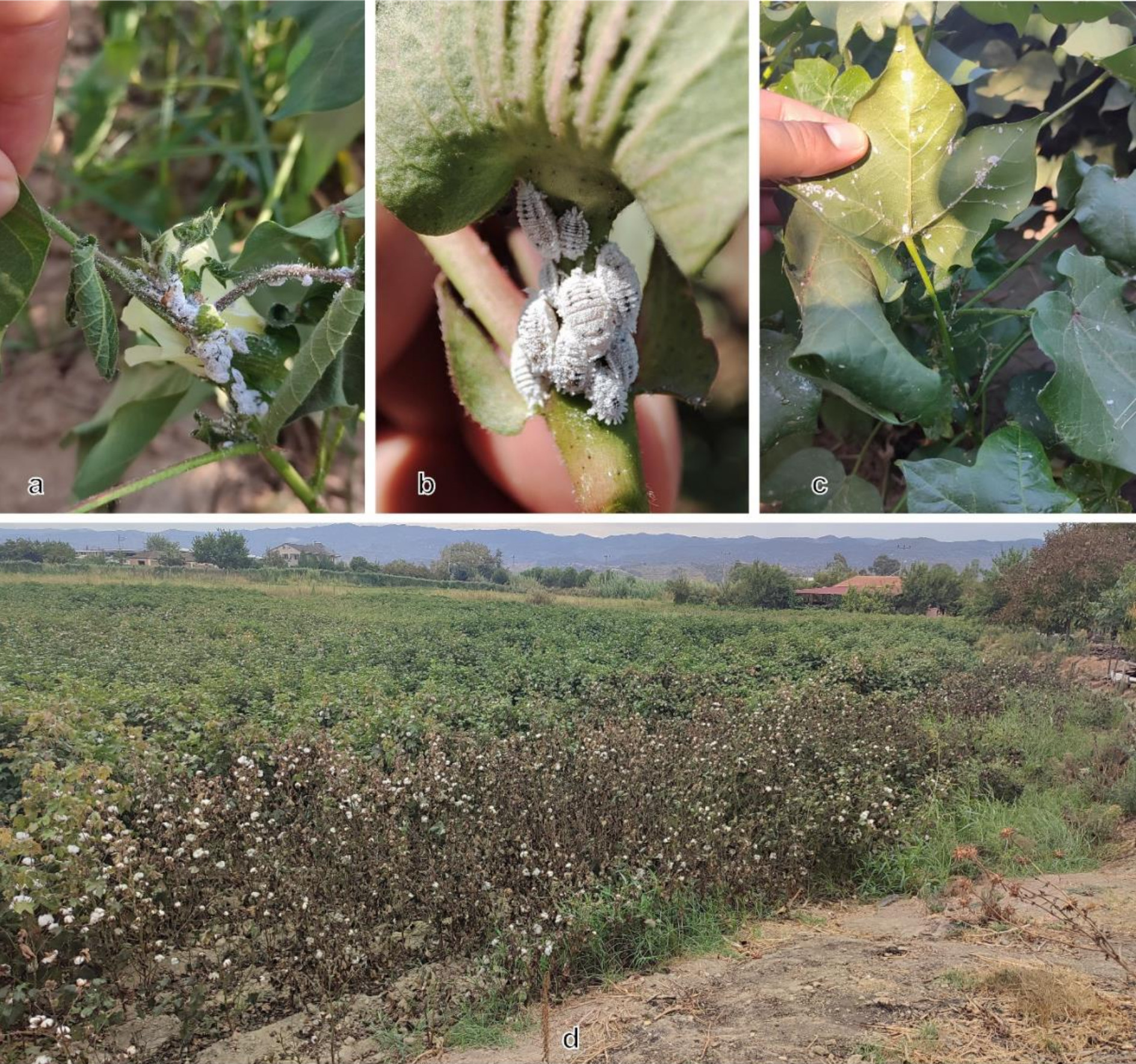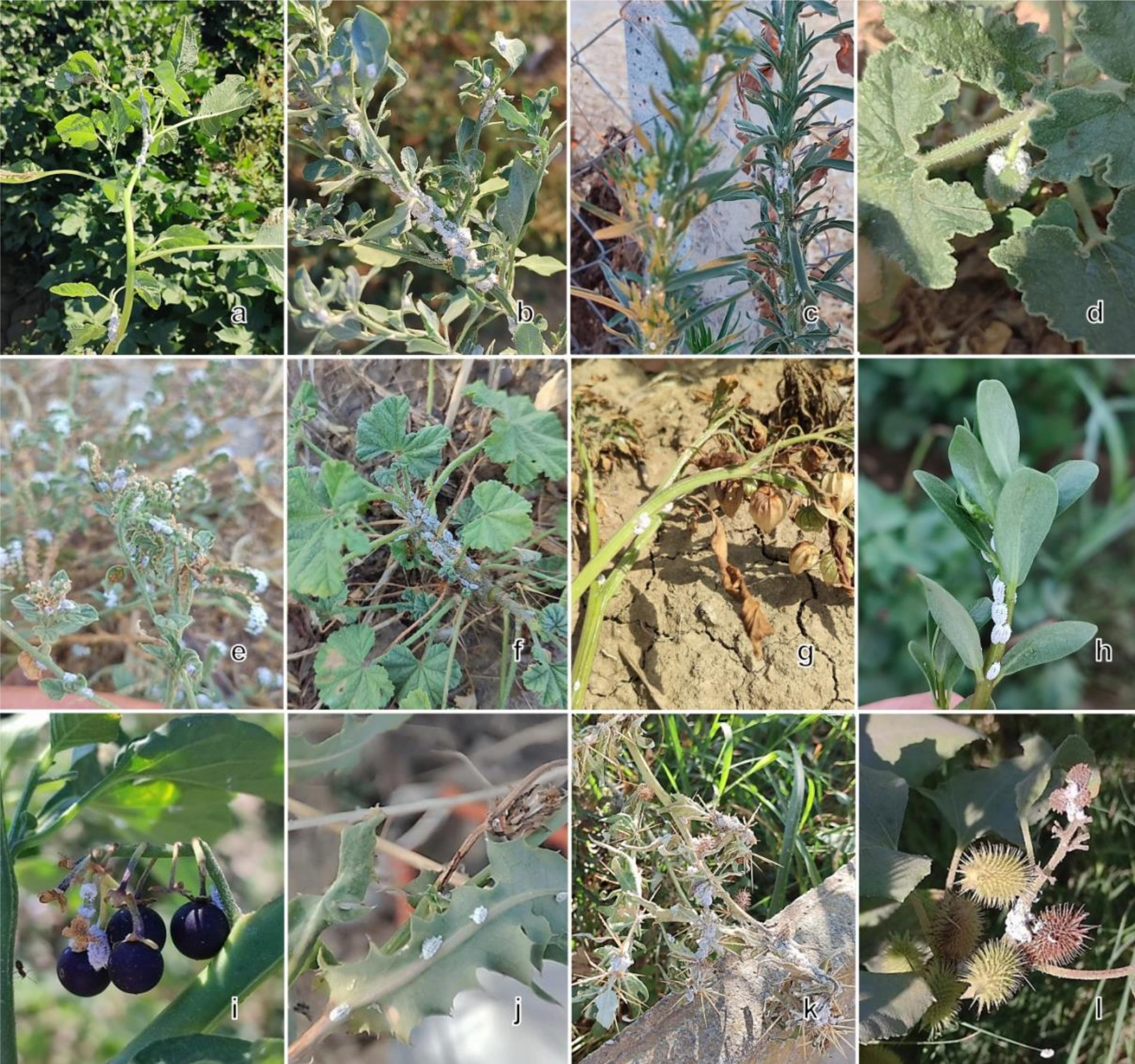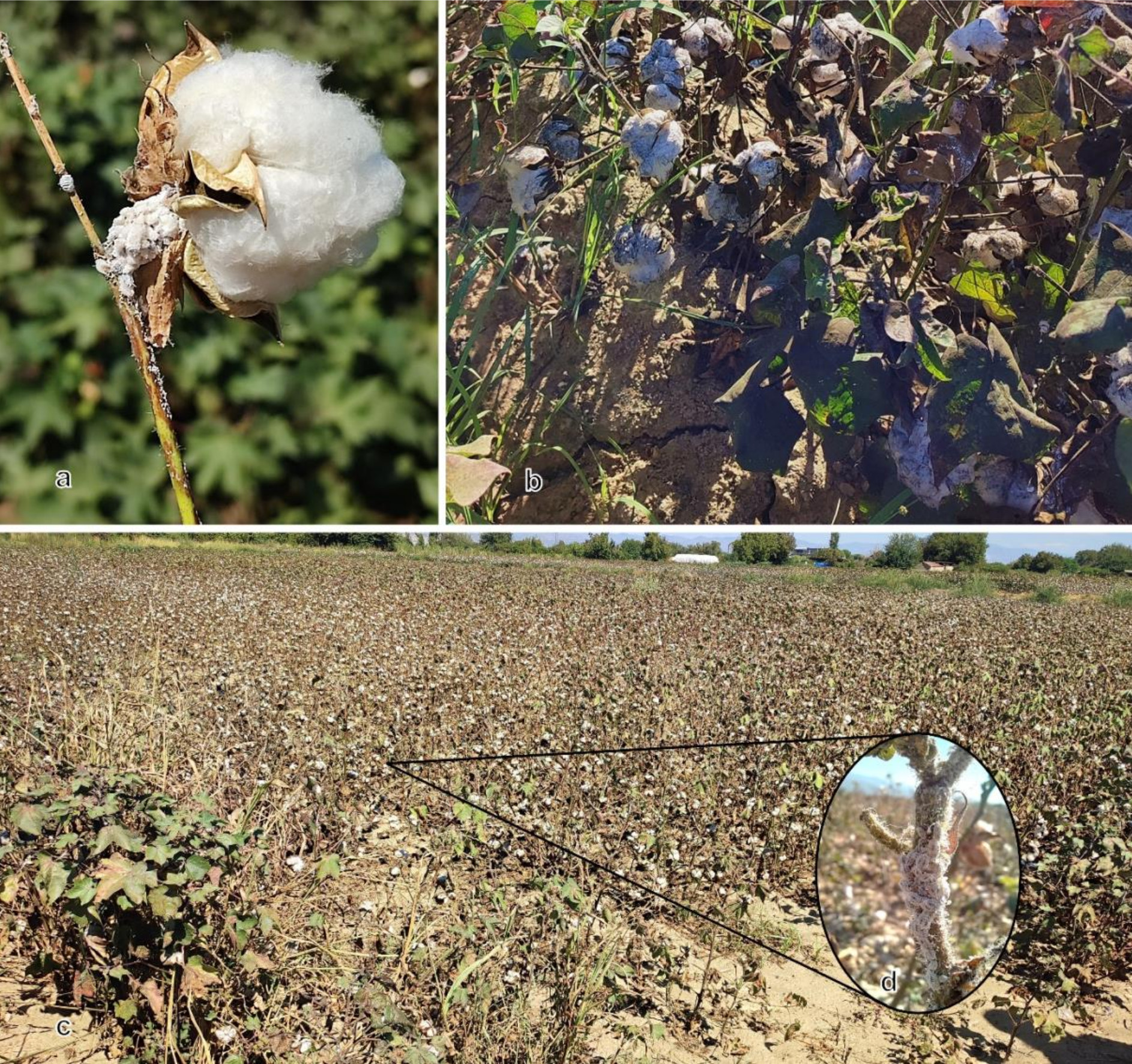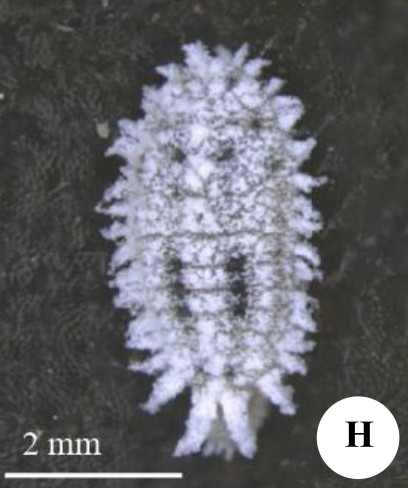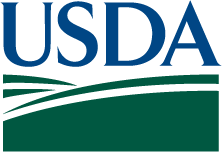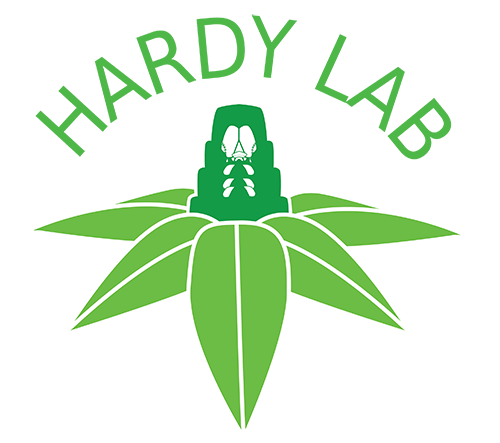Valid Names Results
Phenacoccus solenopsis Tinsley, 1898 (Pseudococcidae: Phenacoccus)Nomenclatural History
- Phenacoccus solenopsis Tinsley 1898a: 47. Type data: U.S.A.: New Mexico, A.T.M. College, found with the ant Solenopsis geminata Fabricius; collected October 1897.. Lectotype, female, by subsequent designation (HodgsoAbAr2008,4). Type depository: Washington: United States National Entomological Collection, U.S. National Museum of Natural History, District of Columbia, USA; accepted valid name
- Phenacoccus cevalliae Cockerell 1902s: 115. Type data: U.S.A.: New Mexico, near Lea Lake, east of Roswell, on Cevallia sinuata.. Syntypes, female, by subsequent designation Type depository: Washington: United States National Entomological Collection, U.S. National Museum of Natural History, District of Columbia, USA; junior synonym (discovered by Ferris1950b, 161).
- Phenacoccus gossypiphilous Abbas, Arif & Saeed 2005: 83. nomen nudum (discovered by HodgsoAbAr2008, 4).
- Phenacoccus solepnosis Tinsley, 1898; Shah, et al. 2015. misspelling of species epithet
- Phencoccus solenopsis; Weintraub, et al. 2017. misspelling of genus name
- Phenaccocus solenopsis; Nawaz & Freed 2022: 275. misspelling of genus name
- Planococcus solenopsis; Awadalla et al. 2023: 297. misspelling of genus name
- Phenacoccus solenoposis Tinsley, 1898; Bi et al. 2023: 1. misspelling of species epithet
- Phenococcus Solenopsis; Das et al. 2024: 962. misspelling of genus name
Common Names
- solenopsis mealybug Koszta1996 McKenz1967
- Kuroten-kona-kaigaramushi TanakaUe2012
- cotton mealybug AbdRabEv2021
- Chinese hibiscus mealybug KondoWaTa2022
- cochinilla algodonosa del algodón KondoWaTa2022
- بق القطن الدقيقى AbdRab2012
Ecological Associates
Hosts:
Families: 69 | Genera: 242
- Acanthaceae
- Aphelandra squarrosa | ArifRaGh2009
- Pachystachys lutea | MacharKiHe2021
- Ruellia elegans | SpodekBeMo2018
- Ruellia simplex | YerlikBaKa2023 | (= Ruellia brittoniana)
- Ruellia squarrosa | ArifRaGh2009
- Ruellia tuberosa | KedarSa2015
- Aizoaceae
- Mesembryanthemum cordifolium | YerlikBaKa2023 | (= Aptenia cordifolia)
- Tetragonia tetragonioides | SpodekBeMo2018
- Trianthema portulacastrum | ArifRaGh2009 SinghShKu2012 SahitoAbKa2011 | (= Trianthema monogyna),
- Trianthema triquetra | ArifRaGh2009
- Amaranthaceae
- Achyranthes aspera | ArifRaGh2009 SahuJoGa2019 SahitoAbKa2011
- Aerva javanica | ArifRaGh2009 | (= Aerva persica)
- Alternanthera ficoidea | AbdulRMaHe2015 | (= Alternanthera ficoidea)
- Amaranthus cruentus | AbbasArAs2010 | (=Amaranthus paniculatus)
- Amaranthus hybridus | HembaMuLe2012 PitanBaAd2011
- Amaranthus retroflexus | FallahAbSa2014
- Amaranthus spinosus | ShahidArGo2017 PitanBaAd2011 AslamHaMa2018
- Amaranthus viridis | ArifRaGh2009 AslamHaMa2018
- Atriplex canescens | BenDov1994 Tinsle1898c
- Atriplex crassifolia | AbbasArAs2010
- Bassia indica | ArifRaGh2009 SuroshGaFa2013
- Beta vulgaris | KedarSa2015
- Celosia argentea | ArifRaGh2009
- Chenopodium album | ArifRaGh2009 FallahAbSa2014 AbbasArAs2010
- Chenopodium leptophyllum | SuroshGaFa2013
- Chenopodium murale | ArifRaGh2009 AslamHaMa2018
- Digera | ArifRaGh2009
- Digera muricata | ShahidArGo2017 AslamHaMa2018 | (= Digera arvensis),
- Iresine herbstii | AbdulRMaHe2015
- Maireana sedifolia | SpodekBeMo2018
- Salsola baryosma | ArifRaGh2009
- Spinacia oleracea | SpodekBeMo2018
- Suaeda | BenDov1994 McKenz1967
- Suaeda fructicosa | ArifRaGh2009
- Anacardiaceae
- Anacardium occidentale | MaruthSi2015
- Mangifera indica | ArifRaGh2009 GermaiVaMa2010 ChowdhRa2024
- Annonaceae
- Annona muricata | LincanHoCa2010
- Annona squamosa | PachecKaSi2019
- Polyalthia longifolia | ArifRaGh2009
- Apiaceae
- Daucus carota | ArifRaGh2009
- Apocynaceae
- Adenium obesum | SpodekBeMo2018
- Allamanda blanchetii | SpodekBeMo2018
- Calotropis gigantea | SahuJoGa2019
- Calotropis procera | ArifRaGh2009 FallahAbSa2014
- Catharanthus roseus | YerlikBaKa2023 | (= Vinca rosea)
- Gymnema sylvestre | ShivakKePo2022
- Marsdenia nigriflora | MilleHeCa2016
- Nerium oleander | ArifRaGh2009 FallahAbSa2014 | (=Nerium indicum),
- Plumeria rubra | ArifRaGh2009 | (= Plumeria acutifolia)
- Tabernaemontana divaricata | ArifRaGh2009 | (= Tabernaemontana coronaria)
- Trachelospermum jasminoides | YerlikBaKa2023
- Araceae
- Anthurium andraeanum | AslamHaMa2018
- Arecaceae
- Phoenix dactylifera | ArifRaGh2009
- Asparagaceae
- Asparagus aethiopicus | ArifRaGh2009 | (= Asparagus sprengeri)
- Asparagus setaceus | ArifRaGh2009 | (= Asparagus plumosus)
- Asteraceae
- Achillea | BenDov1994 McKenz1967
- Ageratina adenophora | ZhouBiXu2015 | (= Eupatorium adenophorum)
- Ageratum conyzoides | ArifRaGh2009
- Ambrosia | BenDov1994 McKenz1967
- Ambrosia artemisiifolia | BenDov1994 McKenz1967
- Ambrosia tenuifolia | Granar2003
- Artemisia frigida | NewtonGlMa2011
- Aster amellus | YerlikBaKa2023
- Asteriscus graveolens | SpodekBeMo2018
- Bidens bipinnata | AttiaAwNo2017
- Calendula officinalis | ArifRaGh2009
- Carthamus oxyacantha | AbbasArAs2010
- Centaurea cyanus | ArifRaGh2009
- Chondrilla juncea | YerlikBaKa2023
- Chromolaena odorata | PitanBaAd2011
- Chromoleana odotata | AssefaDi2018
- Chrysanthemum | YerlikBaKa2023 ViorenSaMa2025
- Chrysanthemum indicum | KedarSa2015
- Chrysanthemum morifolium | ArifRaGh2009
- Cichorium intybus | ArifRaGh2009
- Cirsium arvense | ArifRaGh2009 AslamHaMa2018 | (= Cnicus arvensis),
- Cirsium lecontei | ArifRaGh2009
- Conyza bonariensis | YerlikBaKa2023
- Cyanus segetum | ArifRaGh2009
- Eclipta prostrata | ShahidArGo2017 AslamHaMa2018
- Encelia farinosa | BenDov1994 Ferris1950b
- Enceliopsis | BenDov1994 McKenz1967
- Erigeron bonariensis | ArifRaGh2009 AslamHaMa2018 | (= Conyza bonariensis),
- Erigeron canadensis | SpodekBeMo2018 | (= Conyza canadensis)
- Eriophyllum | BenDov1994 Ferris1950b
- Eupatorium perfoliatum | DineshVe2016
- Franseria | BenDov1994 McKenz1967
- Helianthus | BenDov1994 McKenz1967
- Helianthus annuus | ArifRaGh2009 FallahAbSa2014
- Lactuca saligna | YerlikBaKa2023
- Lactuca sativa | SpodekBeMo2018
- Laggera aurita | PitanBaAd2011
- Launaea nudicaulis | ShahidArGo2017 AslamHaMa2018
- Osteospermum ecklonis | SpodekBeMo2018
- Pallenis spinosa | YerlikBaKa2023
- Parthenium hysterophorus | ArifRaGh2009 KedarSaRa2013 AslamHaMa2018
- Platyschkuhria integrifolia | ArifRaGh2009
- Scalesia atractyloides | LincanHoCa2010
- Sonchus oleraceus | ArifRaGh2009
- Tagetes | ArifRaGh2009
- Tagetes erecta | KedarSa2015
- Tagetes patula | KedarSa2015
- Taraxacum campylodes | ArifRaGh2009 | (= Taraxacum officinale)
- Tripolium pannonicum | AbdulRMaHe2015 | (= Aster tripolium)
- Xanthium spinosum | YerlikCoKa2024
- Xanthium strumarium | ArifRaGh2009 FallahAbSa2014 AslamHaMa2018
- Zinnia violacea | FallahAbSa2014
- Bignoniaceae
- Tecoma alata | SpodekBeMo2018
- Tecoma stans | ArifRaGh2009
- Boraginaceae
- Euploca strigosa | ArifRaGh2009
- Heliotropium europaeum | ArifRaGh2009
- Heliotropium indicum | AbbasArAs2010
- Heliotropium strigosum | ArifRaGh2009
- Heliotropium suaveolens | SpodekBeMo2018
- Brassicaceae
- Brassica rapa | ElekciKa2021 | ssp. nipposinica
- Eruca sativa | SpodekBeMo2018
- Lepidium didymum | ArifRaGh2009 ShahidArGo2017 | (= Coronopus didymus)
- Lepidium sativum | AbbasArAs2010
- Bromeliaceae
- Ananas comosus | SpodekBeMo2018
- Cactaceae
- Hylocereus | RezekiHaSa2021
- Opuntia megacantha | ElAalaSb2024
- Selenicereus undatus | SartiaSaSy2020 | (=Hylocereus undatus)
- Cannabaceae
- Cannabis sativa | AbbasArAs2010
- Capparaceae
- Capparis decidua | ArifRaGh2009
- Caricaceae
- Carica papaya | MartinFoCu2015
- Celastraceae
- Euonymus japonicus | YerlikBaKa2023
- Cleomaceae
- Cleome viscosa | ArifRaGh2009
- Combretaceae
- Combretum indicum | ArifRaGh2009 | (= Quisqualis indica)
- Commelinaceae
- Commelina benghalensis | PitanBaAd2011
- Tradescantia pallida | ArifRaGh2009 | (= Sectreasia purpurea)
- Convolvulaceae
- Convolvulus arvensis | ArifRaGh2009 FallahAbSa2014 ShahidArGo2014
- Convolvulus prostratus | ArifRaGh2009 | (= Convolvulus pluricaulis)
- Cressa cretica | ArifRaGh2009
- Cuscuta reflexa | ArifRaGh2009
- Ipomoea cairica | ArifRaGh2009
- Ipomoea tricolor | FallahAbSa2014
- Jacquemontia pentantha | ArifRaGh2009
- Cucurbitaceae
- Citrullus colocynthis | ArifRaGh2009 FallahAbSa2014
- Citrullus lanatus | ArifRaGh2009 FallahAbSa2014
- Cucumis | SinghShKu2012
- Cucumis melo | AbbasArAs2010
- Cucumis sativus | AbbasArAs2010
- Cucumis tetragona | ArifRaGh2009
- Cucurbita | BenDov1994 WilliaGr1992
- Cucurbita moschata | ChenShCh2024 AbbasArAs2010
- Ecballium elaterium | SpodekBeMo2018
- Lagenaria siceraria | ArifRaGh2009 FallahAbSa2014
- Luffa | FallahAbSa2014
- Luffa cylindrica | ArifRaGh2009
- Momordica charantia | ArifRaGh2009 FallahAbSa2014
- Telfairia occidentalis | PitanBaAd2011
- Cycadaceae
- Cycas revoluta | AbdulRMaHe2015
- Cyperaceae
- Cyperus rotundus | ArifRaGh2009
- Ebenaceae
- Diospyros kaki | SpodekBeMo2018
- Euphorbiaceae
- Acalypha wilkesiana | ArifRaGh2009
- Chrozophora tinctoria | SpodekBeMo2018
- Codiaeum variegatum | KedarSa2015
- Croton bonplandianus | ArifRaGh2009 | (= Croton sparsiflorus)
- Euphorbia | BenDov1994 McKenz1967
- Euphorbia chamaesyce | SpodekBeMo2018
- Euphorbia cotinifolia | ArifRaGh2009
- Euphorbia granulata | AbbasArAs2010
- Euphorbia hirta | ArifRaGh2009 AbbasArAs2010
- Euphorbia maculata | SpodekBeMo2018
- Euphorbia prostrata | ArifRaGh2009 AbbasArAs2010
- Euphorbia pulcherrima | GermaiSoBu2014
- Euphorbia serpens | SpodekBeMo2018
- Euphorbia trigona | BenDov1994 WilliaGr1992
- Euphorbiaceae | GranarSz2007
- Jatropha integerrima | ArifRaGh2009
- Manihot esculenta | ParsaKoWi2012 MurthyChRa2025 MurthyChRa2025
- Ricinus communis | ArifRaGh2009 FallahAbSa2014
- Fabaceae
- Acacia leucophloea | ArifRaGh2009
- Acacia modesta | ArifRaGh2009
- Albizia lebbeck | ArifRaGh2009
- Alhagi maurorum | YerlikCoKa2024 | subsp. maurorum
- Bauhinia purpurea | ArifRaGh2009
- Cajanus cajan | EFSA2021e
- Cassia fistula | ArifRaGh2009
- Cyamopsis tetragonoloba | ArifRaGh2009
- Dalbergia sissoo | ArifRaGh2009
- Desmodium incanum | MirabaGaCa2018 | (= Desmodium canum)
- Glycyrrhiza glabra | YerlikCoKa2024
- Lupinus | BenDov1994 McKenz1967
- Medicago orthoceras | ArifRaGh2009
- Medicago polymorpha | ArifRaGh2009 AbbasArAs2010 | (= Medicago denticulata),
- Medicago sativa | ElAalaSb2024
- Melilotus albus | AbbasArAs2010 | (=Medicago alba)
- Melilotus indicus | ArifRaGh2009 AbbasArAs2010
- Prosopis farcta | SpodekBeMo2018
- Prosopis juliflora | HembaMuLe2012
- Sesbania sesban | ArifRaGh2009
- Trigonella polycerata | ArifRaGh2009
- Vachellia nilotica | FallahAbSa2013 FallahAbSa2014 | (= Acacia nilotica)-
- Vigna unguiculata | YerlikCoKa2024 PitanBaAd2011
- Geraniaceae
- Pelargonium | SpodekBeMo2018
- Pelargonium domesticum | YerlikBaKa2023
- Lamiaceae
- Ballota nigra | YerlikBaKa2023
- Clerodendrum | SpodekBeMo2018
- Coleus scutellarioides | ArifRaGh2009 ArifRaGh2009 | (= Coleus blumei),
- Mentha longifolia | ArifRaGh2009
- Mentha piperita | ArifRaGh2009
- Mentha spicata | ArifRaGh2009 FallahAbSa2014
- Ocimum basilicum | ArifRaGh2009
- Ocimum gratissimum | PitanBaAd2011
- Salvia | FallahAbSa2014
- Salvia officinalis | ArifRaGh2009
- Thymus vulgaris | SpodekBeMo2018
- Vitex agnus-castus | SpodekBeMo2018
- Volkameria inermis | ShahidArGo2017 | (= Clerodendron inerme)
- Loasaceae
- Cevallia sinuata | BenDov1994 Cocker1902s
- Lythraceae
- Lagerstroemia indica | ArifRaGh2009
- Lawsonia inermis | ArifRaGh2009
- Punica granatum | ArifRaGh2009
- Malvaceae
- Abelmoschus esculentus | ArifRaGh2009 FallahAbSa2014 SuroshGaFa2013 SahitoAbKa2011 PitanBaAd2011 MohameTaAd2019
- Abelmoschus moschatus | SahuJoGa2019
- Abutilon fruticosum | FallahAbSa2013 FallahAbSa2014
- Abutilon hirtum | ArifRaGh2009 FallahJaAb2014
- Abutilon indicum | ArifRaGh2009 AbbasArAs2010
- Abutilon muticum | ArifRaGh2009
- Abutilon pannosum | MohameTaAd2019
- Abutilon theophrasti | AssefaDi2018 SahitoAbKa2011
- Alcea rosea | KedarSa2015
- Althaea | BenDov1994 McKenz1967
- Althaea officinalis | YerlikBaKa2023
- Alyogyne huegelii | SpodekBeMo2018
- Bombax ceiba | ArifRaGh2009 | (= Salmalia malabarica )
- Brachychiton rupestris | SpodekBeMo2018
- Corchorus depressus | ArifRaGh2009 | (= Corchorus antichorus)
- Corchorus neocaledonicus | MilleHeCa2016
- Corchorus olitorius | PitanBaAd2011
- Corchorus trilocularis | ArifRaGh2009 HembaMuLe2012
- Gossypium | BenDov1994 FallahAbSa2013 FallahAbSa2014 McKenz1967
- Gossypium arboreum | ArifRaGh2009
- Gossypium barbadense | DafaalRuHa2022
- Gossypium herbaceum | AssefaDi2018
- Gossypium hirsutum | ArifRaGh2009 HodgsoAbAr2008 AbbasArAs2010
- Grewia asiatica | ArifRaGh2009
- Hibiscus | AbdRabGeMa2010 HodgsoAbAr2008 KondoRaVe2008
- Hibiscus cannabinus | SahuJoGa2019
- Hibiscus mutabilis | ArifRaGh2009 SahitoAbKa2011
- Hibiscus rosa-sinensis | AkintoAn2008 ArifRaGh2009 BenDov1994 Moghad2010 SartiaWaNo2016 WilliaGr1992 WuZh2009 MacharKiKo2018 ChowdhRa2024 AbbasArAs2010
- Hibiscus sabdarifa | SuroshGaFa2013
- Hibiscus sabdariffa | GalvezMuGo2023
- Hibiscus schizopitalus | KedarSa2015
- Hibiscus syriacus | KedarSa2015
- Hibiscus tiliaceus | SpodekBeMo2018
- Malva parviflora | ArifRaGh2009 | (= Melilotus parviflora)
- Malvastrum coromandelianum | ArifRaGh2009
- Malvaviscus arboreus | ArifRaGh2009
- Malvella sherardiana | SpodekBeMo2018
- Sida acuta | SahuJoGa2019
- Sida urens | BenDov1994 WilliaGr1992
- Theobroma cacao | KoffiBaDe2025
- Meliaceae
- Melia azedarach | ArifRaGh2009 FallahAbSa2014 | (= Azadirachta indica)
- Trichilia havanensis | MirabaGaCa2018
- Menispermaceae
- Tinospora cordifolia | ArifRaGh2009
- Moraceae
- Artocarpus heterophyllus | ChowdhRa2024
- Broussonetia papyrifera | ArifRaGh2009
- Ficus | ViorenSaMa2025
- Ficus benghalensis | ArifRaGh2009 ChowdhRa2024
- Ficus carica | ArifRaGh2009 FallahAbSa2014
- Ficus lacor | ArifRaGh2009
- Ficus religiosa | FallahAbSa2014
- Ficus virens | ArifRaGh2009 | (= Ficus infectoria)
- Morus alba | ArifRaGh2009 FallahAbSa2014
- Musaceae
- Musa acuminata | ElFatiMoAh2015
- Myrtaceae
- Callistemon citrinus | YerlikBaKa2023
- Eucalyptus camaldulensis | ArifRaGh2009
- Melaleuca leucadendra | ArifRaGh2009
- Psidium guajava | LincanHoCa2010 ChowdhRa2024
- Nyctaginaceae
- Boerhavia diffusa | AbbasArAs2010
- Boerhavia repens | ArifRaGh2009
- Boerhavia spicata | BenDov1994 Tinsle1898c
- Bougainvillea glabra | ArifRaGh2009
- Bougainvillea spectabilis | AbbasArAs2010
- Mirabilis jalapa | YerlikBaKa2023
- Oleaceae
- Jasminum cuspidatum | ArifRaGh2009
- Jasminum officinale | YerlikBaKa2023
- Jasminum sambac | ArifRaGh2009
- Olea europaea | SpodekBeMo2018
- Orobanchaceae
- Orobanche | BenDov1994 McKenz1967 WilliaGr1992
- Oxalidaceae
- Oxalis corniculata | ArifRaGh2009
- Papaveraceae
- Fumaria indica | AbbasArAs2010
- Passifloraceae
- Passiflora edulis | SpodekBeMo2018
- Pedaliaceae
- Sesamum indicum | Gebreg2018 SahitoAbKa2011
- Sesamum orientale | ArifRaGh2009 FallahAbSa2013 FallahAbSa2014
- Phyllanthaceae
- Phyllanthus amarus | PitanBaAd2011
- Phyllanthus niruri | ArifRaGh2009
- Piperaceae
- Piper betle | ArifRaGh2009
- Piper nigrum | BuangAmAd2025
- Pittosporaceae
- Pittosporum tobira | YerlikBaKa2023
- Plantaginaceae
- Antirrhinum | SpodekBeMo2018
- Antirrhinum majus | EFSA2021e
- Poaceae
- Acrachne racemosa | SinghShKu2012
- Cynodon dactylon | ArifRaGh2009 FallahAbSa2014
- Echinochloa colona | ArifRaGh2009 SahitoAbKa2011
- Eleusine indica | ArifRaGh2009
- Eragrostis minor | ArifRaGh2009
- Pennisetum glaucum | SinghShKu2012
- Sorghum halepense | SpodekBeMo2018
- Zea mays | AssefaDi2018
- Polygonaceae
- Persicaria barbata | ArifRaGh2009 | (= Polygonum barbatum)
- Persicaria glabra | ArifRaGh2009 | (= Polygonum glabrum)
- Rumex dentatus | ArifRaGh2009
- Portulacaceae
- Portulaca | HembaMuLe2012
- Portulaca grandiflora | ArifRaGh2009 AbbasArAs2010
- Portulaca oleracea | ArifRaGh2009 AbbasArAs2010
- Primulaceae
- Lysimachia arvensis | ArifRaGh2009 SahitoAbKa2011 | (=Anagallis arvensis),
- Rhamnaceae
- Ziziphus mauritiana | ArifRaGh2009 FallahAbSa2014
- Rosaceae
- Eriobotrya japonica | YerlikBaKa2023
- Prunus dulcis | SpodekBeMo2018
- Pyrus | PachecKaSi2019
- Rosa chinensis | MohameTaAd2019
- Rosa indica | ArifRaGh2009
- Rubiaceae
- Gardenia jasminoides | ArifRaGh2009
- Hamelia patens | ArifRaGh2009
- Rubiaceae | BenDov1994 WilliaGr1992
- Rutaceae
- Citrus aurantium | ArifRaGh2009
- Citrus limon | ArifRaGh2009
- Citrus paradisi | SpodekBeMo2018
- Citrus sinensis | ArifRaGh2009 SpodekBeMo2018
- Salvadoraceae
- Salvadora oleoides | ArifRaGh2009
- Sapindaceae
- Cupania americana | MirabaGaCa2018
- Dodonaea viscosa | FallahAbSa2014
- Scrophulariaceae
- Leucophyllum candidum | SpodekBeMo2018
- Leucophyllum frutescens | SpodekBeMo2018
- Solanaceae
- Capsicum | YerlikBaKa2023
- Capsicum annuum | SpodekBeMo2018 AbbasArAs2010 PitanBaAd2011
- Capsicum frutescens | ArifRaGh2009 FallahAbSa2014
- Cestrum diurnum | ArifRaGh2009
- Cestrum nocturnum | ArifRaGh2009 FallahAbSa2014
- Datura metel | ArifRaGh2009 AbbasArAs2010 | (=Datura alba)
- Datura stramonium | HembaMuLe2012 SahitoAbKa2011
- Lycianthes rantonnetii | SpodekBeMo2018
- Nicotiana plumbaginifolia | ArifRaGh2009
- Nicotiana tabacum | ArifRaGh2009 FallahAbSa2014 AbbasArAs2010
- Petunia integrifolia | FallahAbSa2014
- Physalis | BenDov1994 WilliaGr1992
- Physalis alkekengi | ArifRaGh2009
- Physalis minima | SahuJoGa2019
- Solanum | BenDov1994 McKenz1967
- Solanum aethiopicum | ArifRaGh2009 CulikMaZa2013
- Solanum americanum | CulikMaZa2013
- Solanum lycopersicum | ArifRaGh2009 CulikGu2005 FallahAbSa2014 KedarSa2015 AbbasArAs2010 PitanBaAd2011 MohameTaAd2019 | (= Lycopersicon esculentum),,,
- Solanum macrocarpon | JansenAl2023
- Solanum mauritianum | AssefaDi2018
- Solanum melongena | ArifRaGh2009 FallahAbSa2014 AbbasArAs2010
- Solanum muricatum | Larrai2002
- Solanum nigrum | ArifRaGh2009 FallahAbSa2013 FallahAbSa2014 SahitoAbKa2011
- Solanum ptychanthum | AssefaDi2018
- Solanum tuberosum | ArifRaGh2009 FallahAbSa2014 AbbasArAs2010
- Solanum villosum | SpodekBeMo2018
- Solanum virginianum | ArifRaGh2009 | (= Solanum surratense)
- Withania somnifera | ArifRaGh2009 FallahAbSa2014 SahitoAbKa2011
- Urticaceae
- Laportea aestuans | PitanBaAd2011
- Pilea serpyllacea | AbdulRMaHe2015
- Verbenaceae
- Duranta erecta | ArifRaGh2009 AbbasArAs2010 | (= Duranta repens),
- Lantana camara | ArifRaGh2009 BenDov1994 FallahAbSa2013 FallahAbSa2014 WilliaGr1992 SahitoAbKa2011
- Lantana montevidensis | SpodekBeMo2018
- Verbena officinalis | ArifRaGh2009
- Vitaceae
- Vitis vinifera | SpodekBeMo2018
- Zamiaceae
- Zamia furfuracea | SpodekBeMo2018
- Zingiberaceae
- Elettaria cardamomum | ArifRaGh2009
- Zygophyllaceae
- Fagonia cretica | ArifRaGh2009
- Kallstroemia californica | ArifRaGh2009
- Tribulus terrestris | ArifRaGh2009 AbbasArAs2010
Foes:
Families: 25 | Genera: 66
- Amaryllidaceae
- Allium sativum | ModaffGiUr2025 | essential oil
- Anthocoridae
- Anthocoris muraleedharani | TongAoLi2019
- Blaptostethus pallescens | TongAoLi2019
- Orius niger | ElAalaSb2021
- Aphelinidae
- Coccophagus | TongAoLi2019
- Marietta leopardina | SuroshGaFa2013
- Marietta picta | ChenLiPa2021
- Myiocnema comperei | ChenLiPa2021
- Braconidae
- Asobara persimilis | ElAalaSb2021
- Cecidomyiidae
- Dicrodiplosis manihoti | SpodekBeMo2018
- Chrysopidae
- Chrysoperla carnea | SpodekBeMo2018 KhanSaAk2012
- Chrysoperla mutata | AhmedApKa2023
- Chrysoperla zastrowi | TongAoLi2019
- Mallada | TongAoLi2019
- Plesiochrysa ramburi | HayashOwYo2025 HayashOwYo2025
- Clavicipitaceae
- Metarhizium anisopliae | AnwarNaJa2020 KhanzaKhSy2020
- Coccinellidae
- Brumoides suturalis | KedarSaPa2011 SahuJoGa2019
- Cheilomenes propinqua | AhmedApKa2023
- Cheilomenes sexmaculata | FallahAbSa2013 KedarSaPa2011 ZhouLuZe2012 | (= Menochilus sexmaculata)
- Chilocorus nigrita | TongAoLi2019
- Coccinella septempunctata | AliPeYo2014 KedarSaPa2011
- Coccinella transversalis | KedarAnJo2024
- Coccinella trifasciata | TongAoLi2019
- Coccinella undecimpunctata | TongAoLi2019
- Cryptolaemus montrouzieri | SpodekBeMo2018 KhanSaAk2012
- Diomus leondai | CostaRGoSa2020
- Exochomus nigripennis | SpodekBeMo2018
- Exochomus nigromaculatus | DafaalRuHa2022
- Exochomus pubescens | SpodekBeMo2018
- Harmonia dimidiata | TongAoLi2019
- Hippodamia convergens | TongAoLi2019
- Hippodamia variegata | KedarSaPa2011 | (= Adonia variegata)
- Hyperaspis maindroni | TongAoLi2019
- Hyperaspis polita | MadihRaZa2021 SeyfolEsMo2016 SpodekBeMo2018
- Hyperaspis vinciguerra | SpodekBeMo2018
- Illeis | AlfredDAsPa2020
- Lemnia biplagiata | TongAoLi2019
- Nephus | FallahAbSa2013 KedarSaPa2011
- Nephus (Sidis) hiekei | RamezaToZa2021
- Nephus arcuatus | MoghadWa2022
- Nephus quadrimaculatus | TongAoLi2019
- Nephus regularis | TongAoLi2019
- Oenopia conglobata | AhmedApKa2023
- Oenopia sauzeti | TongAoLi2019
- Parexochomus nigripennis | RicupePoRu2025
- Pharoscymnus varius | SpodekBeMo2018
- Propylea japonica | TongAoLi2019
- Scymnus | FallahAbSa2013 KedarSaPa2011
- Scymnus (Pullus) syriacus | FallahAbSa2013
- Scymnus coccivora | KumariSuKu2021 VidyaBh2017
- Scymnus flagellisiphonatus | SpodekBeMo2018
- Scymnus interruptus | ElAalaSb2021
- Scymnus nubilus | TongAoLi2019
- Tenuisvalvae notata | SantosCaPe2017
- Cordycipitaceae
- Beauveria bassiana | KhanzaKhSy2020 NawazFr2022
- Isaria farinosa | KhanzaKhSy2020
- Lecanicillium lecanii | KhanzaKhSy2020 | (= Verticillium lecanii)
- Lecanicillium muscarium | Rajabp2024
- Encyrtidae
- Acerophagus | ChenLiPa2021
- Acerophagus coccois | ZhouLuZe2012
- Aenasius | FallahJaAb2014 Hayat2009 TanakaUe2012
- Aenasius arizonensis | Nalini2016 QinLyYa2023 DhaunrWaJi2019 SpodekBeMo2018 | India & Pakistan, | (= Chalcaspis arizonensis, Aenasius bambawalei),,
- Anagyrus agraensis | ChenLiPa2021
- Anagyrus aligarhensis | CaliskHaUl2016
- Anagyrus californicus | SpodekBeMo2018
- Anagyrus dactylopii | TongAoLi2019
- Anagyrus diversicornis | CaliskHaUl2016
- Anagyrus jenniferae | ChenLiPa2021
- Anagyrus kamali | Nalini2016
- Anagyrus loecki | TongAoLi2019
- Anagyrus matritensis | RicupePoRu2025
- Anagyrus mirzai | TongAoLi2019
- Anagyrus osmoi | ChenLiPa2021
- Anagyrus tristis | ChenLiPa2021
- Aphycus primus | JaposhYeKa2023
- Cheiloneurus | TongAoLi2019
- Cheiloneurus nankingensis | LiYaXu2020 QinLyYa2023
- Cheiloneurus paralia | JaposhYeKa2023
- Dicarnosis ripariensis | LomeliLiGo2021
- Encyrtus aurantii | TongAoLi2019
- Ericydnus apterogenes | JaposhYeKa2023
- Gyranusoidea indica | ChenLiPa2021
- Homalotylus albiclavatus | TongAoLi2019
- Homalotylus ephippium | JaposhYeKa2023
- Homalotylus eytelwenii | TongAoLi2019
- Leptomastix algirica | SpodekBeMo2018
- Leptomastix baspinari | JaposhYeKa2023
- Leptomastix dactylopii | ChenLiPa2021
- Leptomastix epona | CaliskHaUl2016
- Leptomastix flava | FallahJa2017
- Leptomastix mayri | ChenLiPa2021
- Metaphycus | ChenLiPa2021
- Paranathrix tachikawai | SuroshGaFa2013
- Prochiloneurus aegyptiacus | TirunaSa2024
- Prochiloneurus bolivari | FallahJa2017
- Prochiloneurus javanicus | TongAoLi2019
- Prochiloneurus nagasakiensis | TongAoLi2019
- Prochiloneurus pulchellus | TirunaSa2024 TirunaSa2024 TirunaSa2024
- Prochiloneurus stenopterus | ChenLiPa2021
- Prochiloneurus testaceus | ChenLiPa2021
- Prochiloneurus uyguni | CaliskHaUl2016
- Pseudleptomastix squammulata | SpodekBeMo2018
- Eulophidae
- Aprostocetus bangaloricus | TongAoLi2019
- Aprostocetus minutes | TongAoLi2019
- Aprostocetus mymaridis | ElAalaSb2021
- Aprostocetus purpurea | SuroshGaFa2013
- Geocoridae
- Geocoris | TongAoLi2019
- Geocoris megacephalus | ElAalaSb2021
- Hemerobiidae
- Sympherobius elegans | AhmedApKa2023
- Sympherobius fallax | AhmedApKa2023
- Lycaenidae
- Spalgis epeus | TongAoLi2019
- Spalgis epius | DineshVe2016
- Morganellaceae
- Photorhabdus luminescens | ElAalaRaKa2024
- Ophiocordycipitaceae
- Purpureocillium lilacinum | KhanzaKhSy2020 | (= Paecilomyces lilacinus)
- Phytoseiidae
- Amblyseius swirskii | ElAalaRaKa2025
- Platygasteridae
- Allotropa | KiranKSuGu2024
- Allotropa phenacocca | TongAoLi2019
- Pleosporaceae
- Alternaria destruens | ElAalaRaKa2024
- Alternaria murispora | ElAalaRaKa2024
- Pseudomonadaceae
- Pseudomonas fluorescens | SrinivShNa2024
- Pteromalidae
- Pachyneuron leucopiscida | TongAoLi2019
- Promuscidea unfasciativentris | Hayat2009 TongAoLi2019
- Reduviidae
- Rhynocoris kumarii | TongAoLi2019
- Rhynocoris marginatus | KitherKuBa2018
- Scelionidae
- Trissolcus basalis | ElAalaSb2021
- Signiphoridae
- Chartocerus kerrichi | TongAoLi2019
- Chartocerus walkeri | SuroshGaFa2013
- Streptomycetaceae
- Streptomyces bellus | ElAalaRaKa2024 | E23-2
Associates:
Families: 14 | Genera: 20
- Anaplasmataceae
- Wolbachia | HarishAr2022
- Aspergillaceae
- Penicillium citrinum | SivaSeBa2025
- Bacillidae
- Bacillus | NamadaUtRa2025
- Betaproteobacteria
- Candidatus Tremblaya phenacola | IinZhSh2019
- Candidatus Tremblaya princeps | NamadaUtRa2025
- Dicistroviridae
- PhSoV | LuriaSmLa2020
- Enterobacteraceae
- Candidatus Moranella endobia | NamadaUtRa2025
- Enterobacteriaceae
- Enterobacter | NamadaUtRa2025
- Formicidae
- Brachymyrmex admotus | GuindaNoWo2017
- Crematogaster arata | GuindaNoWo2017
- Dorymyrmex bicolor | GuindaNoWo2017
- Lasius niger | NewtonGlMa2011
- Solenopsis geminata | Tinsle1898a
- Solenopsis invicta | ZhouLuZe2012
- Tapinoma melanocephalum | ZhouLuZe2012
- Tetramorium bicarinatum | GuindaNoWo2017
- Morganellaceae
- Arsenophonus | HarishAr2022
- Nectriaceae
- Fusarium equiseti | BiDeZh2023
- Rickettsiaceae
- Rickettsia | HarishAr2022
- Xanthomonadaceae
- Pseudoxanthomonas | NamadaUtRa2025
- Yersiniaceae
- Serratia | NamadaUtRa2025
- incertae sedis
- Cardinium | HarishAr2022
Geographic Distribution
Countries: 78
- Algeria | ArouaKaEr2019
- Argentina
- Cordoba | Granar2003
- Corrientes | Granar2003
- Entre Rios | Granar2003
- Australia
- Queensland | MuniapShWa2011
- Victoria | KondoWa2024
- Bangladesh | CABI2021
- Barbados | CABI2021
- Belize | HodgsoAbAr2008
- Benin | GermaiVaMa2010
- Brazil
- Acre | SantosPe2017
- Bahia | daSilv2012
- Ceara | daSilv2012
- Espirito Santo | CulikGu2005 CulikMaVe2007
- Paraiba | daSilv2012
- Pernambuco | PachecKaSi2019
- Cameroon | HodgsoAbAr2008
- Canada
- Alberta | NewtonGlMa2011
- Canary Islands | GavrilDa2015 PellizPo2017
- Cayman Islands | HodgsoAbAr2008
- Chile | Larrai2002
- China
- Anhui (=Anhwei) | AhmedMaQi2015
- Fujian (=Fukien) | AhmedMaQi2015
- Guangdong (=Kwangtung) | WangWuZh2009 WuZh2009
- Guangxi (=Kwangsi) | ChenZhFu2012
- Hainan | AhmedMaQi2015 WangDaTi2019
- Hubei (=Hupei) | ZhaoWaSu2014
- Hunan | AhmedMaQi2015
- Jiangsu (=Kiangsu) | ZhaoWaSu2014
- Jiangxi (=Kiangsi) | AhmedMaQi2015
- Shanghai | AhmedMaQi2015
- Sichuan (=Szechwan) | ZhaoWaSu2014
- Xianggang (=Hong Kong) | CABI2021
- Xinjiang Uygur (=Sinkiang) | AhmedMaQi2015
- Yunnan | ChenZhFu2012
- Zhejiang (=Chekiang) | ChenZhFu2012
- Colombia | GranarSz2007 KondoRaVe2008
- Cote d'Ivoire (=Ivory Coast) | KoffiBaDe2025
- Cuba | BenDov1994 WilliaGr1992
- Cyprus | KaydanCaUl2013 UlgentHo2019
- Dominican Republic | BenDov1994 HodgsoAbAr2008 WilliaGr1992
- Ecuador | BenDov1994 WilliaGr1992
- Egypt | AbdRabGeMa2010 IbrahiMoEl2015
- Ethiopia | Gebreg2018 HembaMuLe2012
- Fiji | KondoWa2024
- France | KondoWaTa2022
- Galapagos Islands | CaustoPeSi2006 HodgsoAbAr2008 LincanHoCa2010
- Ghana | CABI2021
- Greece | KapantPaMi2024
- Guadeloupe | MatileEt2006
- Guatemala | HodgsoAbAr2008
- Haiti | PerezG2008
- Hawaiian Islands | CABI2021
- India | NagrarKrBi2009
- Andhra Pradesh | MaruthSi2015
- Bihar | CABI2021
- Goa | CABI2021
- Gujarat | SinghDuDh2016
- Haryana | KedarSaRa2013
- Jharkhand | CABI2021
- Karnataka | MaruthSi2015
- Kerala | JoshiSuRe2021 VidyaBh2017
- Madhya Pradesh | MaruthSi2015
- Maharashtra | KharbaDo2011
- NCT Delhi | CABI2021
- Punjab | HodgsoAbAr2008
- Rajasthan | MaruthSi2015
- Sikkim | CABI2021
- Tamil Nadu | HodgsoAbAr2008 SureshCh2008
- Uttar Pradesh | CABI2021
- West Bengal | HalderSeCh2018
- Indonesia | MuniapShWa2011
- Bali | Gavril2017b
- Irian Jaya | Gavril2013
- Java | CABI2021
- Kalimantan (=Borneo) | SartiaSaSy2020
- Iran | MoghadBa2011
- Iraq | AbdulRMaHe2015
- Israel | EliyahPrBl2010
- Italy
- Sicily | RicupeBiRu2021
- Jamaica | HodgsoAbAr2008
- Japan | TanakaUe2012
- Kyushu | TanakaTa2014
- Jordan | JansenAl2023
- Kampuchea (=Cambodia) | CABI2021
- Kenya | MacharKiHe2021
- Laos | CABI2021
- Malaysia | SartiaWaNo2016
- Sarawak | BuangAmAd2025
- Mali | MuniapWaVa2012
- Martinique | MatileEt2006
- Mauritius | GermaiSoBu2014
- Mexico | BenDov1994 WilliaGr1992
- Baja California Norte | LomeliLiGo2021
- Oaxaca | GalvezMuGo2023
- Veracruz | HodgsoAbAr2008
- Morocco | ElAalaSb2021
- Netherlands | KondoWaTa2022
- New Caledonia | HodgsoAbAr2008
- Nicaragua | CABI2021
- Nigeria | AkintoAn2008
- Pakistan | AbbasArSa2005 HodgsoAbAr2008
- Panama | BenDov1994 WilliaGr1992
- Papua New Guinea | KondoWa2024
- Reunion | GermaiMiPa2014
- Ryukyu Islands (=Nansei Shoto) | CABI2021
- Saint Martin & St. Barthelemy
- Saint Barthelemy | EFSA2021e MatileEt2006
- Saint Martin | MatileEt2006
- Saudi Arabia | BaderAl2020
- Senegal | MuniapWaVa2012
- Seychelles | CABI2021
- Sierra Leone | CABI2021
- South Africa | JansenAl2023
- Spain | CABI2021
- Sri Lanka | Sirise2012
- Sudan | ElobeiElAb2019 MohammElAb2019
- Suriname | JansenAl2023
- Swaziland (=Eswatini) | AssefaDi2018 AssefaMa2018
- Taiwan | HodgsoAbAr2008
- Thailand | HodgsoAbAr2008
- Tunisia | AbbesHaWa2023
- Turkey | KaydanCaUl2013
- Uganda | JansenAl2023
- United Arab Emirates | PorcelPe2019
- United States
- Arizona | BenDov1994 Ferris1950b HodgsoAbAr2008
- California | BenDov1994 Ferris1950b HodgsoAbAr2008
- Colorado | CABI2021 McKenz1967
- District of Columbia | BenDov1994 CABI2021 Ferris1950b Koszta1996
- Florida | CABI2021 Halber1998
- Idaho | HodgsoAbAr2008
- Illinois | Koszta1996
- Maryland | Koszta1996
- Michigan | BenDov1994 Ferris1950b Koszta1996
- Mississippi | BenDov1994 Ferris1950b
- Missouri | CABI2021
- Nevada | HodgsoAbAr2008
- New Jersey | HodgsoAbAr2008 Koszta1996
- New Mexico | BenDov1994 HodgsoAbAr2008 Tinsle1898a Tinsle1898c
- New York | Koszta1996
- Ohio | Koszta1996
- Oregon | CABI2021
- Texas | BenDov1994 Ferris1950b HodgsoAbAr2008
- Utah | CABI2021
- Virginia | Koszta1996
- Washington | CABI2021
- Uruguay | PachecKaBa2020
- Vietnam | NguyenHu2008 | CABI2021
Keys
- ViorenSaMa2025: pp.1023 ( Adult (F) ) [Mealybug species found on ornamental plants in West Java, Indonesia]
- PowellDeMo2024: pp.8 ( Adult (F) ) [Slide-mounted Phenacoccus species in Florida]
- EvansAb2023: pp.8-13 ( Adult (F) ) [Pseudococccidae of Egypt]
- TanakaSaCh2022: pp.313 ( Adult (F) ) [Phenacoccus species in Japan]
- MoghadWa2022: pp.87 ( Adult (F) ) [Phenacoccus species in Iran]
- RezekiHaSa2021: pp.3115-3116 ( Adult (F) First instar ) [Species on dragon fruit in Indonesia]
- JoshiSuRe2021: pp.1118-119 ( Adult (F) ) [Field characters of mealybugs in cassava]
- JoshiSuRe2021: pp.119-120 ( Adult (F) ) [Microscopic characters of mealybugs in cassava]
- Hodgso2020: pp.32-34 ( Adult (M) ) [higher groups of Pseudococcidae]
- PachecKaBa2020: pp.504-505 ( Adult (F) ) [Pseudococcidae in Uruguay]
- Moghad2019: pp.454 ( Adult (F) ) [Phenacoccus in Iran]
- Suh2019a: pp.2-6 ( Adult (F) ) [mealybugs interepted in S. Korea]
- SpodekBeMo2018: pp.3-4 ( Adult (F) ) [Phenacoccus in Israel]
- ZhaoWaSu2014: pp.116-117 ( Adult (F) ) [Phenacoccus in China]
- Moghad2013: pp.46 ( ) [Key to species of Phenacoccus Cockerell in Iran]
- TanakaUe2012: pp.414 ( Adult (F) ) [Key to separate four new invasive mealybug species: Dysmicoccus neobrevipes, Ph. defectus, Ph. parvus and P. solenopsis from other mealybugs occurring in the Ryukyu Archipelago]
- ParsaKoWi2012: pp.10-Aug ( Adult (F) ) [Key to mealybugs (Hemiptera: Pseudococcidae) recorded on Manihot spp. (Euphorbiaceae) in the World]
- MoghadBa2011: pp.68 ( Adult (F) ) [Adult females of P. solenopsis and P. solani in Iran]
- Moghad2010: pp.67 ( Adult (F) ) [Phenacoccus species of Iran]
- AbdRabGeMa2010: pp.509 ( Adult (F) ) [Phenacoccus species in Egypt]
- HodgsoAbAr2008: pp.3 ( Adult (F) ) [Species of Phenacoccus of southern Asia]
- GranarSz2007: pp.41-43 ( Adult (F) ) [Phencoccus species of South America]
- Koszta1996: pp.166 ( Adult (F) ) [Northeastern North USA]
- WilliaGr1992: pp.349 ( Adult (F) ) [Central and South America]
- McKenz1967: pp.215 ( Adult (F) ) [U.S.A., California]
- McKenz1964: pp.240 ( Adult (F) ) [North America]
- McKenz1961: pp.27 ( Adult (F) ) [North America]
- McKenz1960: pp.714 ( Adult (F) ) [North America ]
- Ferris1953a: pp.396 ( Adult (F) ) [North America]
- Ferris1950b: pp.121 ( Adult (F) ) [North America]
Remarks
- Systematics: GenBank accession numbers: JX228135
Hodgson et al. (2008) reviewed the morphological differences between Phenacoccus solenopsis Tinsley, P. solani Ferris and P. defectus Ferris, and, based on the morphological variation found in the Asian material, considered that there was some support for the suggestion that these three species might be environmentally-induced variants of a single species. Thomas and Ramamurthy (2014) also found that the important taxonomic characters, such as density of multilocular disc pores and presence of tubular ducts on the first to eighth abdominal segments, exhibited highly significant variations between populations on different hosts, but they found that the populations from cotton, okra and hibiscus were identical in mtCO-1 gene sequences. The phylogenetic tree based on the COI gene shows that there are two distinct evolutionary lineages in P. solenopsis: the first clade includes P. solenopsis from China, India, Pakistan and California, USA; the second clade consists of P. solenopsis from Florida, USA. Among the species in Phenacoccus, the clade of different geographic populations of P. solenopsis and P. solani form a sister-group relationship
Based on morphological characters and mt COI gene sequence analysis, Chen, et al. concluded that these individuals with phenotypic differences are likely true P. solenopsis. However, two distinct evolutionary lineages appear to exist in P. solenopsis, and further evidence is necessary to draw reliable conclusions on the existence of a P. solenopsis complex species.However, a recent study on P. solenopsis suggests the American and Asian populations represent a pair of cryptic species with differences in morphology, ecology, and behavior. (Thomas and Ramamurthy, 2014). Ahmed, et al. analyzed a total of 108 COI sequences for genetic identity and distribution analysis of P. solenopsis. The results show two groups, an Asian group and a New World group, based on genetic distances, phylogenetic analysis, and genetic networking analysis. The Asian group is further divided into nine unique haplotypes (H1–H9), with H1 and H2 having the most widespread distribution across China, Pakistan, and India. They also analyzed the genetic identities and diversity of the P. solenopsis parasitoid A. bambawalei, and they found that it had two unique haplotypes. The locations of these two haplotypes interestingly correlated with two unique haplotypes (AsiaH1 and AsiaH2) of the Asian group of P. solenopsis.
Conflicting data was found in public databases when three sequences of “Phenacoccus solani” and three of Phenacoccus solenopsis shared the same haplotype. (Oliviera et al., 2023) - Structure: Colour photograph of adult females by Hodgson et al. (2008). The adult female usually has patches of dark grey cuticle bare of white mealy wax, with three pairs of submarginal patches on the abdomen and one pair on the thorax. (Sartiami, et al, 2016) Phenacoccus solenopsis shows considerable phenotypic variation, both in its appearance in life (or in alcohol) and in its morphology. This presents a challenge for making accurate identification. The sample collected in Guangxi province contained a few specimens with the dark dorsal submedial spots, but most of the specimens lacked obvious dark spots. After soaking in 80% ethanol, a few specimens showed faint spots while most of the unstriped specimens showed no dorsal pigmentation. The unpigmented phenotype of P. solenopsis has also been observed in California. (Zhao, et al., 2014) Typical Phenacoccus solenopsis specimens can be identified based on the following: they have 9-segmented antennae; the venter of abdominal segments VI–VIII have multilocular disc pores in the median and submedian areas, those on segment VII being at both the anterior and posterior ends of the segment; the femurs have transparent pores; and the circulus is relatively large. Phenacoccus solenopsis will also occasionally have a few multilocular disc pores present in the submargin of abdominal segments II–VII (variable in number and position) and small clusters of oral collar tubular ducts in the margins of the last few abdominal segments (fewer than 35 per side) (Dewer, et al., 2018)
- Biology: Usually occurring above ground, but sometimes living in ants' nests (Solenopsis sp.) and on the roots of its host plants.
The mutualism between Solenopsis invicta and Phenacoccus solenopsis facilitates population increase and fitness of each other. Although native ants may also establish mutualistic relationships with P. solenopsis, S. invicta tends to acquire more honeydew and therefore play a predominant role. P. solenopsis colony growth resulting from tending by S. invicta depends on the food supply of S. invicta. One reasonable conclusion based on this finding is that the absence of animal based food may compel fire ants to exploit honeydew excessively, which may lead to a significant decrease in the fitness of P. solenopsis colonies on host plants. Also, tending by S. invicta ants could increase the density of P. solenopsis by interfering with predation and parasitism by natural enemies. The density of mealybug mummies was significantly lower and lady beetles were present less frequently on ant-tended plants. It was determined that the adults were removed by fire ants indiscriminately, which could increase the risk of spreading P. solenopsis because many unserviceable adults were reproductively active (i.e., contained offspring in their oocysts), even though they did not produce much honeydew. (Zhou, et al., 2012)
Fire ants transferred mealybugs into the shelters produced by leaf rollers. The shelters constructed by leaf rollers improved their survival on predator-infested plants. Shelters also enabled ants to monopolize the honeydew produced by the hemipterans. This mutualism between fire ants and mealybugs facilitates the fitness of both species through their interaction. (Zhou, et al., 2012) Wu, et al., 2013 provided behavioral proof of the indirect impact of mutualism between S. invicta and P. solenopsis. Fire ant tending increased the frequency of honeydew excretion by the mealybugs, but the sizes of the honeydew drops were smaller than in the untended treatments.
Except adult longevity and life span other parameters remained same for unmated and mated males; and except adult longevity, fecundity and life span other attributes remained same for unmated and mated females. Female mated only once and only mated ones could lay eggs (167.77 ± 25.57 in 10.22 ± 2.68 days). Unmated females could only generate ovisac and did not lay eggs, or laid unfertile eggs. (Suroshe, et al., 2016) These results were confirmed in the study by Waqas, et al., 2019.
Interestingly, P. solenopsis tends to utilize the curled leaves constructed by leaf roller larvae as shelters to protect itself from the Aenasius bambawalei (Hymenoptera: Encyrtidae), the most dominant and aggressive parasitoid on P. solenopsis in China. When ant-mealybug mutualism is prevalent, mealybugs greatly benefit from the protective shelters in the plants
- Economic Importance: Since at least 2005, this species (possibly introduced) has been causing serious damage to cotton (Gossypium hirsutum) over much of the Sindh and Punjab districts of Pakistan and in north-western India (Hodgson, Abbas et al, 2008). Populations of Phenacoccus solanopsis in Punjab state represent a vast genetic variability. Thus, there is great possibility of development of biotypes which may differ in resistance to insecticides and host plant specificity. This stresses the need for adoption of different control measures strategies based upon existing genetic diversity such as eradication of weed hosts such as parthenium and discouraging growing of okra around the cotton fields. (Singh, et al., 2012) Kedar, et al., 2013 determined that parasitism by wasps was reduced in the presence of ants and for more effective biological control, ant activity over mealybug colonies need to be checked. It has been documented that cotton mealybug is the primary host for A. bambawalei (Hayat, 2009; Ashfaq et al., 2010). Hyperparasitism can impact primary parasitoid populations and cause biological control failure. An expanded use of PCR for hyperparasitoid detection in its primary host may provide additional help in managing mealybug population through biological control. (Ashfaq, et al., 2017) During the last years severe outbreaks were conspicuous in Israel, with severe damage to ornamental plants mainly Hibiscus in urban areas, principally to live fences in residential neighborhoods. It became a serious pest in few cotton fields and bell pepper and tomato greenhouses. (Spodek, et al., 2018) Phenacoccus solenopsis is not regulated in the EU, neither listed by EPPO. It is a quarantine pest in Bangladesh. (EFSA, 2021)
- General Remarks: Hodgson et al. (2008) provided most detailed descriptions and illustrations of the adult female, adult male, and all nymph instars of both sexes. Description and illustration of adult female by Ferris (1950b), McKenzie (1967), Williams & Granara de Willink (1992), Granara de Willink & Szumik (2007) and by Hodgson et al. (2008).
Illustrations
Citations
- AbbasArAs2010: distribution, host, phenology,
- AbbasArSa2005: distribution, economic importance, host, taxonomy, 83-84
- AbbasArSa2008: economic importance, taxonomy, 103
- AbbesHaGu2024: biology, economic importance, host,
- AbbesHaWa2023: disease transmission, dispersal, distribution, honeydew, host, illustration,
- AbdElGZhDe2022: morphology,
- AbdRab2012: list, 613
- AbdRabEv2021: distribution, host, 43
- AbdRabGeMa2010: distribution, host, taxonomy, 509-510
- AbdulRMaHe2015: diagnosis, host,
- AbdullEl2023: control, entomopathogenic fungi,
- AcevedLoRo2024: biological control, economic importance, host, natural enemies,
- AcevedRoLo2024: biological control, 7
- AfzalSh2016: chemical control, economic control, 62-68
- AfzalShBa2015: chemical control, life history, resistance, 779-785
- AfzalShBa2015: genetics, resistance, 741-749
- AfzalShEj2019: reproduction, resistance,
- AfzalshAb2015: control, genetics,
- AhmadAk2016: chemical control, 96-102
- AhmedHaHa2021: control,
- AhmedHeWu2015: dispersal, distribution, 1159
- AhmedMaQi2015: distribution, genetic structure, host, natural enemies, phylogenetics, 907-918
- AhmmedLaKh2024: control, host plant,
- AhsanLiWu2021: biological control, chemistry,
- AkintoAn2008: distribution, host, taxonomy, 1-3
- AlcasiBaLa2025: DNA, 6
- AlfaroVaGo2024: chemical ecology, control,
- AlfredDAsPa2020: distribution, economic importance, host, natural enemies, 994
- AliPeYo2014: biological control, economic importance, host, 7-12
- AlthalAl2025: chemical control, illustration,
- AlthalAl2025: chemical control, economic importance, host, illustration,
- AnwarNaJa2020: entomopathogenic fungi,
- ArifAbSa2007: distribution, economic importance, host, taxonomy, 1-4
- ArifRaGh2009: distribution, economic importance, host, 163-167
- ArouaKaEr2019: distribution, host,
- ArunkuBaGo2018: chemistry, wax, 145-152
- ArunkuBaGo2021: bacteria, control,
- AryaDhUp2018: genetic structure, genetics, life cycle, 1-13
- AryaSiUp2020: control, genetics,
- AshfaqAkAk2017: biological control, 1-4
- AshfaqNoMa2010: molecular data, taxonomy, 395-404
- AslamEhAs2020: biological control, natural enemies,
- AslamHaAs2018: natural enemies, 19-25
- AslamHaMa2018: distribution, ecology, host, phenology,
- AssefaDi2018: DNA sequencing, distribution, host,
- AssefaMa2018: DNA sequencing, distribution, host,
- AttiaAwNo2017: distribution, natural enemies,
- AwadalBaEl2023: biological control, natural enemies,
- BaderAl2020: biology, diagnosis, distribution, host,
- BadrAbMo2020: biology, control, distribution, economic importance, host, illustration, morphology, taxonomy,
- BadshaUlCa2016: biological control, natural enemies, 1605-1616
- BadshaUlFa2015: host, life cycle, natural enemies,
- BadshaUlZa2017: DNA sequencing, taxonomy,
- BaiZuDu2024: endosymbiont, evolution, reproduction,
- BakryAb2024: biology, control, host,
- BanazeAfIj2019: resistance,
- BansalFe2025: control, genetics, resistance, 8
- BeltraGaSo2013: distribution, economic importance, 1486
- BenDov1994: catalog, 344-345
- BhoiJoVy2024: anatomy, distribution, host, illustration, record,
- BhojanDeSh2017: biological control, natural enemies,
- BiDeZh2023: entomopathogenic fungi,
- BouharChQe2025: natural enemies, 9
- BuangAmAd2025: ant association, illustration, molecular biology, morphology, survey, virus,
- CABI2021: diagnosis, distribution, list, natural enemies, taxonomy,
- Calisk2019: ecology, life history,
- CaliskHaUl2016: biological control, distribution, 155-170
- CaliskKaMu2016: life history, reproduction, 75-82
- CatzimCuJu2024: economic importance, 130
- CaustoPeSi2006: distribution, 138
- ChaitaSuKi2025: biological control, ecology, natural enemies, 3
- ChatziSiWa2016: diagnosis, 539-540, 543, 536
- ChenLiPa2021: natural enemies,
- ChenShCh2024: molecular biology, 3
- ChenZhFu2012: description, structure, taxonomy, 443-450
- ChenZhLv2025: genetics, 5
- ChengZeXu2015: ant association, biological control,
- ChoiLe2022: endosymbiont, phylogeny, 358,359
- ChoiPaTa2025: bacteria, endosymbiont, genome, 4
- ChowdhRa2024: distribution, economic importance, host, phenology, survey, 11, 13
- Cocker1902s: description, distribution, host, taxonomy, 315
- CortesIgMo2024: biology, 5
- CostaRGoSa2020: natural enemies,
- CuiZhLi2024: climate change, distribution, ecology,
- CulikGu2005: distribution, host, 1-8
- CulikMaVe2007: distribution, host, 1-5
- CulikMaZa2013: host, 638
- DafaalRuHa2022: biological control, distribution, ecology, host,
- DasYaSa2024: distribution, 962
- DemardBaDi2025: behavior, histology, host, 2, 5, 12
- DengWeMa2025: evolution, genome, illustration, phylogeny, 10, 15
- DewerAbSc2018: DNA, distribution, host, morphology, 155-159
- DhaunrWaJi2019: biological control, ecology, economic importance, nymph,
- DiSoraTuBr2025: entomopathogenic fungi, 10
- DineshVe2016: biological control, natural enemies,
- DivyaKa2019: chemistry, wax,
- DogarAyAb2018: biology, host,
- DongHuZh2025: natural enemies, 1, 2
- DongLeLi2025: control, economic importance, irradiation, male, reproduction,
- EFSA2021: biology, control, economic importance, host, taxonomy, 18, 32-33, 46, 160-177
- EFSA2021b: distribution, host,
- EFSA2021e: biology, dispersal, distribution, host, illustration, taxonomy,
- EFSA2022f: biology, distribution, economic importance, 42, 43, 160-169
- EFSA2024c: dispersal, economic importance, host, list, 23
- EhsasAyIk2024: DNA sequencing, genome, molecular biology,
- EjazAfSh2017: resistance, 8-14
- EjazUlAl2019: genetics, resistance,
- ElAalaMoSb2025: control, heat-treatment, 2
- ElAalaRaBe2025: biological control, entomopathogenic fungi, 2
- ElAalaRaBe2025a: biological control, entomopathogenic fungi, natural enemies, 2, 5, 7
- ElAalaRaBe2025b: biological control, entomopathogenic fungi, illustration, natural enemies,
- ElAalaRaKa2024: bacteria, biological control, entomopathogenic fungi,
- ElAalaRaKa2025: biological control, economic importance, host, natural enemies,
- ElAalaRaKa2025a: biological control, entomopathogenic fungi, host, natural enemies,
- ElAalaRaYa2025: biological control, 2
- ElAalaSb2021: distribution, host, natural enemies,
- ElAalaSb2024a: distribution, economic, natural enemies, reproduction, 453
- ElAalaSb2025: biological control, natural enemies, 3
- ElFatiMoAh2015: distribution, host, illustration, record,
- ElbahrHaEl2020: ecology,
- EldesoTaEs2023: chemical control,
- ElekciKa2021: distribution, host, 9
- ElobeiElAb2019: biology, diagnosis, distribution, host,
- ErensoBlGo2023: phylogeny, 4
- EvansAb2023: distribution, host, illustration, key, taxonomy, 7, 9, 23, 65
- FallahAbSa2013: biological control, distribution, host, 673-679
- FallahAbSa2014: distribution, host, 169-176
- FallahJa2017: distribution, host, natural enemies, 3, 18, 26, 34
- FallahJaAb2014: biological control, description, distribution, economic importance, host, 516
- FandSu2015: control, economic importance,
- FengLiZh2014: biological control, ecology, economic importance, 1333-1338
- FengMiLi2015: ant association,
- Ferris1950b: description, distribution, host, illustration, taxonomy, 161-163
- FranciKaRo2012: biological control, 295
- FrancoCoLu2021: reproduction, 254
- GalaniWa2012: distribution, economic importance, 7
- GalvezMuGo2023: distribution, economic importance, host, illustration,
- Gavril2013: distribution, 75
- Gavril2017b: distribution, 144
- GavrilDa2015: distribution, host, 95
- Gebreg2018: distribution, economic importance, 1-7
- GeethuSuCh2021: ecology, natural enemies,
- GermaiMiPa2014: distribution, 24
- GermaiSoBu2014: distribution, economic importance, host, taxonomy, 28
- GermaiVaMa2010: distribution, host, 126
- GonzalLeEs2019: biological control, entomopathogenic fungi,
- GorgeAbIb2023: biological control,
- Granar2003: distribution, host, 81-82
- GranarSz2007: description, distribution, host, illustration, taxonomy, 105,112
- GrazioMiAl2015: climate change, distribution, economic importance, host, 1071-1073
- Greath1971: biological control, distribution, host,
- GuedesSiZa2019: biology, life cycle, reproduction,
- GuindaNoWo2017: ant association,
- HalderSeCh2018: distribution, host, 74
- HameedAzAh2012: ecology, life cycle, nymph, reproduction,
- HanchiPaBh2010: ecology, natural enemies,
- HarbiAbCh2024: heat-treatment, host, life history, life cycle, natural enemies, reproduction,
- HarbiAbRa2024: biological control, ecology, natural enemies,
- HarishAr2022: Wolbachia, endosymbionts, 241
- HassanKaSh2025: biological control, chemical control, ecology, natural enemies,
- HayashOwYo2025: biological control, distribution, natural enemies,
- Hayat2009: biological control, taxonomy, 21-26
- HembaMuLe2012: description, distribution, economic importance, host, illustration, 60-67
- Hodgso2012: illustration, taxonomy, 62, 63
- Hodgso2020: illustration, key, 33, 35
- HodgsoAbAr2008: description, distribution, economic importance, host, illustration, taxonomy, 1-35
- HodgsoHa2013: phylogeny, taxonomy, 797
- HuangLvDi2025: economic importance, evolution, genome, host,
- HuangYa2023: distribution, economic importance, host, 227
- HuangZhLi2014: distribution, economic importance, 1419-1425
- HuangZhZh2017: ant association, natural enemies,
- HuangZhZh2021: natural enemies,
- IbrahiMoEl2015: distribution, economic importance, host, illustration,
- IinZhSh2019: endosymbiont,
- IjazAfSh2016: chemical control, resistance, 177–186
- IqbalFeFe2021: control, ecology,
- IsmailEjAb2017: chemical control, 38-43
- JalilvShFa2014: distribution, host, natural enemies, 5
- JansenAl2023: dispersal, host, 30,35
- JaposhYeKa2023: natural enemies, 577-582
- JoodakZaZa2018: biological control, natural enemies,
- JoshiRaAm2024: economic importance, 1
- JoshiSuRe2021: diagnosis, distribution, host, illustration, key,
- KapantPaMi2024: DNA sequencing, distribution, host, phylogenetics,
- KarmakSh2018: ecology, natural enemies, 1-11
- KaydanCaUl2013: distribution, economic importance, host, illustration, 169-170
- KaydanEr2025: distribution, host, 1
- KaydanErUl2012: distribution, host, 68
- KaydanKoWi2017: distribution, host, 313
- KedarAnJo2024: economic importance, host, natural enemies, phenology, 4, 10
- KedarAnJo2024: economic importance, host, natural enemies, phenology, 4, 10
- KedarSa2015: host, 297-300
- KedarSaPa2011: ecology, 245-246
- KedarSaRa2012: ecology, host, natural enemies, phenology,
- KedarSaRa2013: distribution, host, 566
- KedarSaRa2013a: biological control, 362-363
- KedarSaRa2013b: behavior, host, life cycle,
- KhanAsKh2015: chemical control,
- KhanAsKh2017: control, genetics,
- KhanSaAk2012: biological control, economic importance,
- KhanShAt2025: biology, natural enemies,
- KhanzaKhSy2020: control, entomopathogenic fungi,
- KhanzaKhSy2021: entomopathogenic fungi,
- KharbaDo2011: distribution, 25-26
- KhudhaKaWa2024: diagnosis, natural enemies,
- KiranKSuGu2024: natural enemies,
- KirankSuCh2025: biological control, heat-treatment, natural enemies,
- KitherKuBa2018: biological control,
- KoffiBaDe2025: DNA, ant association, distribution, host, natural enemies, record, virus transmission, 2, 11
- KohliGuNa2021: genetic structure, symbionts,
- KondoRaVe2008: distribution, host, 40
- KondoWa2022a: distribution, host, list, 24
- KondoWa2024: distribution, 2-3
- KondoWaTa2022: biology, diagnosis, distribution, host, illustration, taxonomy, 172-174
- Koszta1996: description, distribution, host, illustration, life history, taxonomy, 166-168
- KumarKrMo2009: biological control, natural enemies,
- KumaraKoRa2024: biological control, natural enemies, 3
- KumariSuKu2021: natural enemies,
- KumariSuKu2021: natural enemies,
- LaneesSuBa2020: biological control, natural enemies, 459
- Larrai2002: distribution, host, 15-26
- LentinMuMu2018: control, reproduction, 264
- LeonJiVaGo2019: chemical control,
- LiLaFu2015: genetic structure, 761-767
- LiToWa2020: DNA, male, reproduction,
- LiYaXu2020: natural enemies,
- LiesenMaDe2025: genome, molecular biology, 5, 7
- LincanHoCa2010: distribution, host, 6
- LiuNiLu2022: phylogenetics,
- LiuPeXu2024: climate change, dispersal, distribution,
- LomeliLiGo2021: natural enemies,
- LuoZhBi2014: DNA, DNA sequencing, genetics,
- LuriaSmLa2020: virus,
- LysandAhLo2012: chemical control, 493-506
- MaCaGo2019: dispersal, genetic structure,
- MacharKiHe2021: distribution, host, 7
- MadihRaZa2021: biological control, natural enemies,
- MamoonAbAl2024: control, natural enemies,
- MamoonAbTa2016: control, natural enemies,
- MamoonKhAb2012: host, life cycle, nymph, phenology, reproduction,
- MansooShRa2024: resistance, 5
- MartinFoCu2015: distribution, host,
- MartinLa2011: catalog, distribution, host, 48
- MaruthSi2015: distribution, host, natural enemies,
- MatileEt2006: distribution, host, 182
- McKenz1967: description, distribution, host, illustration, taxonomy, 277-280
- MendezVaBe2019: control,
- Meurge2011: distribution, 82
- MiddleDeDi2024: natural enemies, 10
- MilleHeCa2016: distribution, economic importance, host, 150
- MirabaGaCa2018: distribution, host, 194
- ModaffGiUr2025: biological control, nymph, 344
- ModaffUrAu2025: biological control, 2
- Moghad2010: distribution, host, taxonomy, 68
- Moghad2013: description, distribution, host, illustration, structure, taxonomy, 60, 62-63, 99
- Moghad2013: distribution, host, illustration, structure, taxonomy, 60, 62-63, 99
- Moghad2013a: distribution, host, 70
- Moghad2019: key, 454
- Moghad2020: distribution, 384
- MoghadAbFa2021: diagnosis, distribution, economic importance, host, illustration, life history, natural enemies, 291-293
- MoghadAl2010: taxonomy, 16
- MoghadBa2011: distribution, illustration, taxonomy, 67-69
- MoghadNe2021: distribution, 175
- MoghadWa2022: diagnosis, distribution, economic importance, host, illustration, key, 11, , 103-105, 147
- MoghadWa2024: economic importance, 18
- MohameTaAd2019: behavior, distribution, host, nymph,
- MohammElAb2019: biology,
- Moir2020: climate change, economic importance, 1
- MongueWoMa2025: evolution, genome, male, reproduction, 4, 9
- MounisJoKa2025: biological control, chemical ecology, ecology, 5
- MuniapShWa2011: biological control, distribution, host, 168,171
- MuniapWaVa2012: distribution, 1-5
- MuramaTsTa2020: phylogeny, 5
- MurthyChRa2024a: DNA, diagnosis,
- MurthyChRa2025: distribution, host, illustration, survey,
- NagrarKrBi2009: distribution, economic importance, host, 537-541
- NagrarNaDe2018: host, life cycle,
- NagrarNaFa2025: economic importance, host, natural enemies, phenology, 2
- Nalini2015: biological control, natural enemies, 189-193
- Nalini2016: host, natural enemies, 672
- NamadaUtRa2025: control, distribution, economic importance, endosymbiont, host, resistance, vector, wax,
- NasirAsAb2021: distribution, 4
- NawazFr2022: control, entomopathogenic fungi,
- NazarFrHu2020: chemical control, resistance,
- NewtonGlMa2011: distribution, 520
- NguyenHu2008: distribution, economic importance, 3-5
- NieLiXu2016: DNA sequencing, natural enemies, phylogenetics, physiology,
- OliveiSaOl2023: DNA, phylogeny,
- OmarAoLi2019: chemical control, genetics,
- OuZhHu2025: biological control, chemical control, importance, resistance,
- OuvrarKoGu2013: economic importance, 2
- OzodbeKhKo2024: molecular biology, phylogenetics, 3
- PachecBeBl2014: molecular data, 5-9
- PachecBoPr2016: GLRV, biology, control, diagnosis, distribution, illustration, natural enemies,
- PachecKaBa2020: key, phylogeny, 505, 506
- PachecKaSi2019: DNA, distribution, host, phylogeny, 530, 535
- PalmaJBlGu2019: host, 290
- ParsaKoWi2012: taxonomy, 9
- PawarDeBh2017: biological control, natural enemies, 559-563
- PawarDeBh2017a: distribution, ecology, host, natural enemies,
- PellizPo2017: distribution, 108
- PerezG2008: distribution, 216
- PitanBaAd2011: distribution, host, illustration, importance, survey,
- PooranAnTh2024: economic importance, host, illustration, natural enemies, 531, 534
- PooranJoTh2022: diagnosis, distribution, host, illustration,
- PoornaSiMu2025: control, distribution, host, 13-15
- PorcelPe2019: distribution, 186-187
- PowellDeMo2024: illustration, key, 3, 8
- QinLyYa2023: dispersal, natural enemies, 2
- Rajabp2024: chemical control, entomopathogenic fungi,
- RajputSuRa2023: control,
- RamezaToZa2021: economic importance, natural enemies,
- RatheeDa2018: economic importance, 270
- ReddyMiMe2025: dispersal, distribution, economic importance, host, illustration, 3, 10-11, 18
- ReddyRaSe2024: chemical control, physiology, 6
- RenAsHu2017: DNA, phylogeny, 5, 6
- RezekiHaSa2021: diagnosis, host, illustration, key, morphology, 3115
- RezkHaEl2019: chemical control, distribution, host,
- RicupeBiRu2021: dispersal, distribution, host,
- RicupePoRu2025: control, distribution, host, illustration, importance, natural enemies, record,
- RosadeMo2021: distribution, host,
- RossHaOk2012: phylogeny, taxonomy, 199
- RostamHuSh2024: biological control, natural enemies, 1408
- SaddiqAbSh2016: chemical control, economic importance, life history, resistance, 83-90
- SahitoAbKa2011: distribution, host, phenology, survey,
- SahuGaJo2017: ecology, host, life cycle,
- SahuJoGa2019: host, natural enemies, 94, 95
- SahuJoGa2019: biological control, distribution, natural enemies,
- SanghaBhPa2017: biological control, natural enemies, 571-576
- SantosCaPe2017: natural enemies,
- SantosPe2017: diagnosis, distribution, host, illustration, 135-138
- SardarYaZa2023: entomopathogenic fungi,
- SartiaSaSy2020: diagnosis, distribution, history, host, illustration, record, 32
- SartiaWaNo2016: description, distribution, economic importance, host, illustration, 5
- SenthiJaSe2025: host, phenology, 14
- SeyfolEsMo2016: biological control, natural enemies,
- SeyfolEsMo2017: biology,
- SeyfolEsMo2019: natural enemies,
- ShahAdMe2015: control, ecology,
- ShahidAkAh2019: economic importance, host,
- ShahidArGo2014: behavior, host, nymph,
- ShahidArGo2017: chemistry, ecology, host, 211-218
- ShakeeRiWa2018: chemical control, natural enemies, 151-157
- ShankaRiSa2022: biological control, chemical, natural enemies, resistance,
- Shehat2017: biology, distribution, 613–628
- SheraKaSh2017: natural enemies,
- ShivakChKe2024: control, genome, host, illustration,
- ShivakKePo2022: diagnosis, economic importance, host, illustration, natural enemies,
- ShivakPoJo2024: host, 2
- ShobaRaAl2024: chemical ecology, control, distribution, economic importance,
- SiddiqEjAl2017: chemical control,
- SiddiqEjAl2017: chemical control,
- SileshNuZe2019: biology, illustration, life cycle, male, nymph,
- SinghDuDh2016: distribution, ecology, economic importance, 2175-2181
- SinghGuPa2019: control,
- SinghKu2015: chemistry,
- SinghRaPa2025: control, illustration, molecular biology, molecular data, nymph,
- SinghShKu2012: distribution, economic importance, host, molecular data, 539-543
- SiriseWaHe2015: SEM,
- SivaSeBa2025: vector, 11
- SongWaTa2024: genome, phylogeny,
- SosanAjUd2020: distribution, ecology, host,
- SoumiaPaGa2018: ecology, natural enemies,
- SpodekBeMo2018: biology, dispersal, economic importance, host, key, natural enemies, 1-12
- SrinivShNa2024: biological control, chemical, chemical control,
- Suh2019a: key, 5
- SunnyRNaGr2025: DNA, genetics, genome, 9
- SureshCh2008: distribution, economic importance, host, 285-291
- SureshKa2008: distribution, economic importance, host, 155
- SuroshGaFa2013: host, natural enemies,
- SuroshGaFa2016: biology, life cycle, 264-267
- TabataIcMo2017: chemistry, reproduction, 8
- TanakaSaCh2022: key, 313
- TanakaUe2012: biological control, description, distribution, economic importance, host, illustration, structure, taxonomy, 413-419
- ThammaChCh2024: biological control, control,
- ThangaGa2017: biological control, natural enemies, 259-260
- ThimmeSuSa2024: heat-treatment, natural enemies,
- ThomasRa2014: host, morphology, phylogenetics,
- Tinsle1898c: description, distribution, host, taxonomy, 319
- TirunaSa2024: host, natural enemies, record,
- TokunaSeUt2018: distribution, host, 143
- TongAoLi2019: ant association, ecology, evolution, life history,
- TongLiYe2019: behavior, reproduction,
- TongOmWa2024: genetics, genome, life cycle, male, reproduction,
- TurgutUl2007: ant association, 317
- UlgentErYa2022: distribution, host, S125
- UlusoyKaBi2022: control, wax secretion,
- UrvashRe2025: biological control, chemical, resistance, 6
- VeaFiJa2025: genetics, genome, male, reproduction, 6, 8
- VennilDePi2010: distribution, host, life history, 1-9
- VidyaBh2017: distribution, host, natural enemies, 214-215
- ViorenSaMa2025: distribution, host, illustration, key, morphology, survey, 1022
- VonEll2025: distribution, 33
- WangDaTi2019a: DNA sequencing,
- WangLiDe2025: behavior, genetics, phylogenetics,
- WangLiRu2023: symbionts, 2
- WangQiHe2023: behavior, host,
- WangWaZh2010: distribution, economic importance, host, 403-416
- WangWuZh2009: distribution, economic importance, host, 101-106
- WangZeSh2025: control, molecular biology, reproduction,
- WangZhTi2018: distribution, host, 2
- WaqasLiSh2020: ecology, life cycle,
- WaqasQiSh2019: chemical control,
- WaqasShCh2019: biology, reproduction,
- WaqasShEl2020: biological control, reproduction,
- WaqasShYi2021: biology, control, ecology, natural enemies, resistance,
- WardOnBo2024: phylogenetics, 4
- Watson2021: distribution, 526
- WatsonMi2017: dispersal, 34, 35
- WatsonOu2021: dispersal, economic importance, 152
- WeiXuSh2025: genome, 4
- WeiZhCa2015: DNA, DNA sequencing, 925-932
- WeiZhZh2017: climate change, distribution, 1-17
- WeintrReMo2017: distribution, economic importance, 10
- Willia2017a: catalog, list of species, 245, 250
- WilliaGr1992: description, distribution, host, illustration, taxonomy, 388-390
- WilliaMa2012: distribution, host, illustration, 84, 89
- WongsoBoKu2025: chemical control, 2
- WuLiSh2014: phylogenetics,
- WuMaHu2015: DNA, dispersal, distribution, phylogeny,
- WuZeZh2013: ecology, 1343-1349
- WuZh2009: distribution, economic importance, host, taxonomy, 159-162
- XiYaLi2024: DNA, control, economic importance, honeydew, molecular biology,
- XuQiGe2012: dispersal, distribution, list of species, A369
- XuReLu2025: control, distribution, list, 66
- XuSuQu2019: ant association, behavior, natural enemies,
- Yarahm2024: biological control, chemical control, natural enemies,
- YaseenArMa2022: chemical control, resistance,
- YaylaKaCa2024: dispersal, distribution, economic importance, host plant, 61
- YeZhLi2025: DNA, genome, illustration, phylogeny,
- YerlikBaKa2023: distribution, host, illustration, list, 6, 9
- YerlikCoKa2024: climate change, distribution, economic importance, host, illustration, phenology,
- YounasRaFa2022: biological control, host, natural enemies,
- ZarghaReNe2024: distribution, ecology, economic importance, host plant, list, 78
- ZarkanApTu2021: distribution, host, 184
- ZhangHuLu2016: biological control, natural enemies, 1-9
- ZhangHuZh2015: host,
- ZhangJiXi2025: evolution, genome, phylogeny,
- ZhaoLiXu2023: bacteria, chemistry, morphology,
- ZhaoWaSu2014: DNA, economic importance, key, molecular data, phenology, 109–121
- ZhengZhZh2019: genetics,
- ZhouBiXu2015: host, natural enemies,
- ZhouKuGa2015: ant association, ecology,
- ZhouLiZe2014: ant association, natural enemies,
- ZhouLuZe2012: distribution, economic importance, life history, 1-10
- ZhouZeLu2012: ecology, life history, 1-5
- daSilv2012: distribution, economic importance, host, illustration, structure, 467-470
